Form 8-K RAYONIER INC For: Nov 09
UNITED STATES
SECURITIES AND EXCHANGE COMMISSION
WASHINGTON, D.C. 20549
FORM 8-K
CURRENT REPORT
PURSUANT TO SECTION 13 OR 15(d) OF
THE SECURITIES EXCHANGE ACT OF 1934
DATE OF REPORT (DATE OF EARLIEST EVENT REPORTED)
November 9, 2017
RAYONIER INC.
COMMISSION FILE NUMBER 1-6780
Incorporated in the State of North Carolina
I.R.S. Employer Identification Number 13-2607329
1 Rayonier Way
Yulee, Florida 32097
(Principal Executive Office)
Telephone Number: (904) 357-9100
Check the appropriate box below if the form 8-K filing is intended to simultaneously satisfy the filing obligations of the registrant under any of the following provisions:
o | Written communications pursuant to Rule 425 under the Securities Act (17 CFR 230.425) |
o | Soliciting material pursuant to Rule 14a-12 under the Exchange Act (17 CFR 240.14a-12) |
o | Pre-commencement communications pursuant to Rule 14d-2(b) under the Exchange Act (17 CFR 240.14d-2(b)) |
o | Pre-commencement communications pursuant to Rule 13e-4(c) under the Exchange Act (17 CFR 240.13e-4(c)) |
Indicate by check mark whether the registrant is an emerging growth company as defined in Rule 405 of the Securities
Act of 1933 (§230.405 of this chapter) or Rule 12b-2 of the Securities Exchange Act of 1934 (§240.12b-2 of this chapter).
Emerging growth company | o | |||||
If an emerging growth company, indicate by check mark if the registrant has elected not to use the extended transition period for complying with any new or revised financial accounting standards provided pursuant to Section 13(a) of the Exchange Act. | o | |||
RAYONIER INC.
TABLE OF CONTENTS
PAGE | |||||
Item 7.01. | 1 | ||||
Item 9.01. | 2 | ||||
3 | |||||
4 | |||||
ITEM 7.01. | Regulation FD Disclosure |
On November 9, 2017, Rayonier Inc. (the “Company”) posted presentation materials on the investor relations section of the Company’s website at http://phx.corporate-ir.net/phoenix.zhtml?c=91500&p=irol-irhome. Members of the Company’s management may use all or portions of these materials from time to time during the fiscal year ending December 31, 2017 in meetings with or when making presentations to the investment community, current or potential stakeholders and others. The presentation materials are furnished herewith as Exhibit 99.1.
By filing this Current Report on Form 8-K and furnishing the information contained herein, the Company makes no admission as to the materiality of any information in this report that is required to be disclosed solely by reason of Regulation FD. The information contained in the investor presentation is summary information that it is intended to be considered solely in the context of the Company’s Securities and Exchange Commission (“SEC”) filings and other public announcements that the Company may make, by press release or otherwise, from time to time. The Company undertakes no duty or obligation to publicly update or revise the information contained in this report, although it may do so from time to time as management believes is warranted. Any such updating may be made through the filing of other reports or documents with the SEC, through press releases or through other public disclosure.
The information presented in Item 7.01 of this Current Report on Form 8-K and Exhibit 99.1 shall not be deemed to be “filed” for purposes of Section 18 of the Securities Exchange Act of 1934, as amended (the “Exchange Act”), or otherwise subject to the liabilities of that section, unless the Company specifically states that the information is to be considered “filed” under the Exchange Act or specifically incorporates it by reference into a filing under the Securities Act of 1933, as amended, or the Exchange Act.
By filing this, certain statements in this presentation regarding anticipated financial outcomes including Rayonier’s earnings guidance, if any, business and market conditions, outlook, expected dividend rate, Rayonier’s business strategies, including expected harvest schedules, timberland acquisitions, sales of non-strategic timberlands, the anticipated benefits of Rayonier’s business strategies, and other similar statements relating to Rayonier’s future events, developments or financial or operational performance or results, are “forward-looking statements” made pursuant to the safe harbor provisions of the Private Securities Litigation Reform Act of 1995 and other federal securities laws. These forward-looking statements are identified by the use of words such as “may,” “will,” “should,” “expect,” “estimate,” “believe,” “intend,” “project,” “anticipate” and other similar language. However, the absence of these or similar words or expressions does not mean that a statement is not forward-looking. While management believes that these forward-looking statements are reasonable when made, forward-looking statements are not guarantees of future performance or events and undue reliance should not be placed on these statements.
The following important factors, among others, could cause actual results or events to differ materially from those expressed in forward-looking statements that may have been made in this document: the cyclical and competitive nature of the industries in which we operate; fluctuations in demand for, or supply of, our forest products and real estate offerings; entry of new competitors into our markets; changes in global economic conditions and world events; fluctuations in demand for our products in Asia, and especially China; various lawsuits relating to matters arising out of our previously announced internal review and restatement of our consolidated financial statements; the uncertainties of potential impacts of climate-related initiatives; the cost and availability of third party logging and trucking services; the geographic concentration of a significant portion of our timberland; our ability to identify, finance and complete timberland acquisitions; changes in environmental laws and regulations regarding timber harvesting, delineation of wetlands, and endangered species, that may restrict or adversely impact our ability to conduct our business, or increase the cost of doing so; adverse weather conditions, natural disasters and other catastrophic events such as hurricanes, wind storms and wildfires, which can adversely affect our timberlands and the production, distribution and availability of our products; interest rate and currency movements; our capacity to incur additional debt; changes in tariffs, taxes or treaties relating to the import and export of our products or those of our competitors; changes in key management and personnel; our ability to meet all necessary legal requirements to continue to qualify as a real estate investment trust (“REIT”) and changes in tax laws that could adversely affect beneficial tax treatment; the cyclical nature of the real estate business generally; a delayed or weak recovery in the housing market; the lengthy, uncertain and costly process associated with the ownership, entitlement and development of real estate, especially in Florida, which also may be affected by changes in law, policy and political factors beyond our control; unexpected delays in the entry into or closing of real estate transactions; changes in environmental laws and regulations that may restrict or adversely impact our ability to sell or develop properties; the timing of construction and availability of public infrastructure; and the availability of financing for real estate development and mortgage loans.
For additional factors that could impact future results, please see Item 1A - Risk Factors in the Company’s most recent Annual Report on Form 10-K and similar discussion included in other reports that we subsequently file with the Securities and Exchange Commission (the “SEC”).
Forward-looking statements are only as of the date they are made, and the Company undertakes no duty to update its forward- looking statements except as required by law. You are advised, however, to review any further disclosures we make on related subjects in our subsequent reports filed with the SEC.
1
ITEM 9.01. | Financial Statements and Exhibits. |
(d) | Exhibits. |
The following is filed as an Exhibit to this Report.
Exhibit No. | Exhibit Description | ||
99.1 | Investor Presentation, dated November 2017. | ||
2
SIGNATURE
Pursuant to the requirements of the Securities Exchange Act of l934, the registrant has duly caused this Report to be signed on its behalf by the undersigned hereunto duly authorized.
RAYONIER INC. (Registrant) | ||
BY: | /s/ APRIL TICE | |
April Tice | ||
Director, Financial Services and Corporate Controller | ||
November 9, 2017
3
EXHIBIT INDEX
EXHIBIT NO. | DESCRIPTION | LOCATION | ||
99.1 | Furnished herewith. | |||
4

Investor Relations | August 2017
Investor Day Presentation | November 2017

Investor Day | November 2017
Safe Harbor Statement
Forward-Looking Statements - Certain statements in this presentation regarding anticipated financial outcomes including Rayonier’s earnings guidance, if any,
business and market conditions, outlook, expected dividend rate, Rayonier’s business strategies, including expected harvest schedules, timberland acquisitions, sales
of non-strategic timberlands, the anticipated benefits of Rayonier’s business strategies, and other similar statements relating to Rayonier’s future events,
developments or financial or operational performance or results, are “forward-looking statements” made pursuant to the safe harbor provisions of the Private
Securities Litigation Reform Act of 1995 and other federal securities laws. These forward-looking statements are identified by the use of words such as “may,” “will,”
“should,” “expect,” “estimate,” “believe,” “intend,” “project,” “anticipate” and other similar language. However, the absence of these or similar words or expressions
does not mean that a statement is not forward- looking. While management believes that these forward-looking statements are reasonable when made, forward-
looking statements are not guarantees of future performance or events and undue reliance should not be placed on these statements.
The following important factors, among others, could cause actual results or events to differ materially from those expressed in forward-looking statements that may
have been made in this document: the cyclical and competitive nature of the industries in which we operate; fluctuations in demand for, or supply of, our forest
products and real estate offerings; entry of new competitors into our markets; changes in global economic conditions and world events; fluctuations in demand for our
products in Asia, and especially China; various lawsuits relating to matters arising out of our previously announced internal review and restatement of our consolidated
financial statements; the uncertainties of potential impacts of climate-related initiatives; the cost and availability of third party logging and trucking services; the
geographic concentration of a significant portion of our timberland; our ability to identify, finance and complete timberland acquisitions; changes in environmental laws
and regulations regarding timber harvesting, delineation of wetlands, and endangered species, that may restrict or adversely impact our ability to conduct our
business, or increase the cost of doing so; adverse weather conditions, natural disasters and other catastrophic events such as hurricanes, wind storms and wildfires,
which can adversely affect our timberlands and the production, distribution and availability of our products; interest rate and currency movements; our capacity to incur
additional debt; changes in tariffs, taxes or treaties relating to the import and export of our products or those of our competitors; changes in key management and
personnel; our ability to meet all necessary legal requirements to continue to qualify as a real estate investment trust (“REIT”) and changes in tax laws that could
adversely affect beneficial tax treatment; the cyclical nature of the real estate business generally; a delayed or weak recovery in the housing market; the lengthy,
uncertain and costly process associated with the ownership, entitlement and development of real estate, especially in Florida, which also may be affected by changes
in law, policy and political factors beyond our control; unexpected delays in the entry into or closing of real estate transactions; changes in environmental laws and
regulations that may restrict or adversely impact our ability to sell or develop properties; the timing of construction and availability of public infrastructure; and the
availability of financing for real estate development and mortgage loans.
For additional factors that could impact future results, please see Item 1A - Risk Factors in the Company’s most recent Annual Report on Form 10-K and similar
discussion included in other reports that we subsequently file with the Securities and Exchange Commission (“SEC”). Forward-looking statements are only as of the
date they are made, and the Company undertakes no duty to update its forward-looking statements except as required by law. You are advised, however, to review
any further disclosures we make on related subjects in our subsequent reports filed with the SEC.
Non-GAAP Financial Measures - To supplement Rayonier’s financial statements presented in accordance with generally accepted accounting principles in the
United States (“GAAP”), Rayonier uses certain non-GAAP measures, including “cash available for distribution,” and “Adjusted EBITDA,” which are defined and further
explained in this communication. Reconciliation of such measures to the nearest GAAP measures can also be found in this communication. Rayonier’s definitions of
these non-GAAP measures may differ from similarly titled measures used by others. These non-GAAP measures should be considered supplemental to, and not a
substitute for, financial information prepared in accordance with GAAP.
1

Investor Day | November 2017
Today’s Presenters and Agenda
Rayonier Today Dave Nunes | President & Chief Executive Officer
Deconstructing Timberland Returns Mark McHugh | SVP & Chief Financial Officer
Timber Segments Overview Doug Long | SVP, U.S. Operations
Real Estate / HBU Strategy Chris Corr | SVP, Real Estate & Public Affairs
Portfolio Management Strategy Rhett Rogers | VP, Portfolio Management
Closing Remarks, Q&A Dave Nunes
2

Investor Day | November 2017
Rayonier Today
3
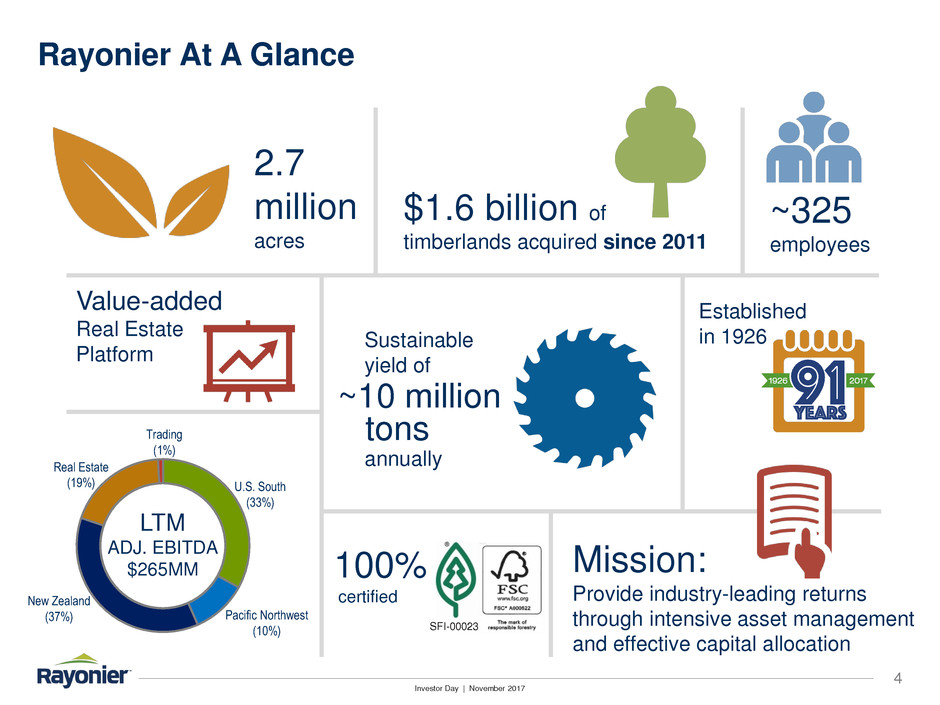
Investor Day | November 2017
New Zealand
(37%)
Real Estate
(19%)
Pacific Northwest
(10%)
U.S. South
(33%)
Rayonier At A Glance
4
2.7
million
acres
LTM
ADJ. EBITDA
$265MM
$1.6 billion of
timberlands acquired since 2011
100%
certified
Value-added
Real Estate
Platform
~325
employees
Established
in 1926
Mission:
Provide industry-leading returns
through intensive asset management
and effective capital allocation
Trading
(1%)
SFI-00023
~10 million
tons
annually
Sustainable
yield of

Investor Day | November 2017
MISSION STATEMENT
The Rayonier Roadmap to Success
Our focused long-term strategy,
coupled with our strong culture, will
chart the path to achieving our vision.
Provide industry-leading
returns through intensive asset
management and effective
capital allocation
Long-term strategy focused on
creating value from our
timberlands and HBU portfolio
Strategy
STRATEGY
Working together as a team with
empowered people and strong
core values
Strategy
CULTURE
Building long-term value per
share through nimble capital
allocation
StrategyCAPITAL
ALLOCATION
VISION
▪ Preferred timberland investment
vehicle for institutional investors
▪ Best-in-class assets, operations,
disclosure and transparency
▪ Preferred employer for forestry
and land management
professionals
5

Investor Day | November 2017
6
Rayonier’s Strategic Priorities
MANAGE FOR
LONG-TERM
VALUE
ACQUIRE
HIGH-QUALITY
TIMBERLANDS
OPTIMIZE
PORTFOLIO
VALUE
FOCUS ON
QUALITY OF
EARNINGS
ENHANCE
DISCLOSURE
Design harvest strategy to achieve long-term, sustainable yield
Balance biological growth, harvest cash flow and responsible stewardship
Focus on harvest operations and rural land sales to support dividends
De-emphasize sale of “non-strategic” timberlands to augment cash flow
Establish Rayonier as industry leader in transparent disclosure
Provide investors with meaningful information about timberland portfolio
Opportunistically monetize lands where premium valuations can be achieved
Pursue value creation activities on select properties to enhance long-term value
Pursue acquisitions that improve portfolio quality and sustainable yield
Maintain disciplined approach to acquisitions, minimize HBU speculation
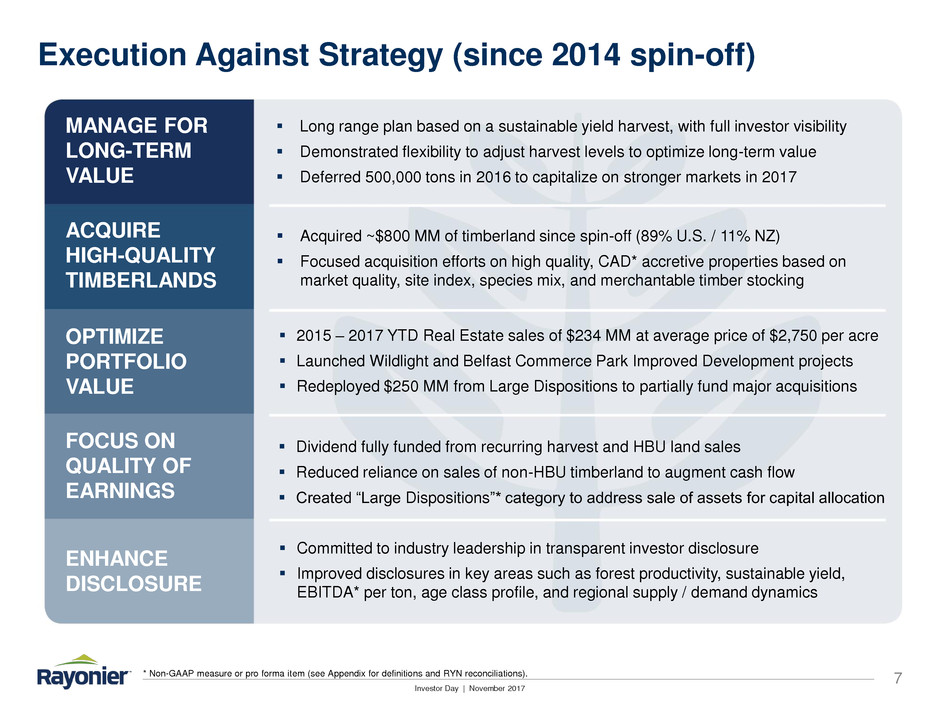
Investor Day | November 2017
7
Execution Against Strategy (since 2014 spin-off)
Long range plan based on a sustainable yield harvest, with full investor visibility
Demonstrated flexibility to adjust harvest levels to optimize long-term value
Deferred 500,000 tons in 2016 to capitalize on stronger markets in 2017
Dividend fully funded from recurring harvest and HBU land sales
Reduced reliance on sales of non-HBU timberland to augment cash flow
Created “Large Dispositions”* category to address sale of assets for capital allocation
Committed to industry leadership in transparent investor disclosure
Improved disclosures in key areas such as forest productivity, sustainable yield,
EBITDA* per ton, age class profile, and regional supply / demand dynamics
2015 – 2017 YTD Real Estate sales of $234 MM at average price of $2,750 per acre
Launched Wildlight and Belfast Commerce Park Improved Development projects
Redeployed $250 MM from Large Dispositions to partially fund major acquisitions
Acquired ~$800 MM of timberland since spin-off (89% U.S. / 11% NZ)
Focused acquisition efforts on high quality, CAD* accretive properties based on
market quality, site index, species mix, and merchantable timber stocking
MANAGE FOR
LONG-TERM
VALUE
ACQUIRE
HIGH-QUALITY
TIMBERLANDS
OPTIMIZE
PORTFOLIO
VALUE
FOCUS ON
QUALITY OF
EARNINGS
ENHANCE
DISCLOSURE
* Non-GAAP measure or pro forma item (see Appendix for definitions and RYN reconciliations).

Investor Day | November 2017
Historical Returns / Correlation by Asset Class
8
Annualized Total Returns (1991 – Q3 2017)
Timberland investment has consistently provided durable total returns with low correlation to
the broader market and alternatives.
Source: NCREIF, FTSE, NAREIT, Bloomberg, SNL Datasource, Factset.
Correlation (1991 – Q3 2017)
Why Timber?1
Why Now?2
Why RYN?3
11.9%
11.4%
11.0%
10.2%
9.8%
8.1%
6.0% 6.0%
2.6%
2.3%
–
2.0%
4.0%
6.0%
8.0%
10.0%
12.0%
14.0%
0.45
0.29
0.25
0.17
0.17
0.17
0.12
0.03
(0.04)
U.S. 3-Month T-Bill
Inflation - CPI
NCREIF Farmland
MSCI EAFE
S&P 500
Russell 2000
Aggregate U.S. Bond Index
FTSE U.S. All Equity REITs
NCREIF Real Estate

Investor Day | November 2017
Timberland Risk vs. Return
9
Timberland Exhibits Low Volatility Historically
Timberland has historically achieved strong relative returns while exhibiting materially lower
volatility, thus reducing portfolio risk.
Source: NCREIF, FTSE, NAREIT, Bloomberg, SNL Datasource, Factset, Hancock Natural Resource Group.
Illustrative Risk Efficient Frontiers
Why Timber?1
Why Now?2
Why RYN?3
R² = 0.4635
–
2.0%
4.0%
6.0%
8.0%
10.0%
12.0%
14.0%
– 5.0% 10.0% 15.0% 20.0%
A
n
n
u
a
li
z
e
d
T
o
ta
l
Ret
u
rn
Standard Deviation
CPI
U.S. 3-Month T-Bill
Bloomberg Barclays
Aggregate U.S. Bond Index
NCREIF Timberland Index
MSCI EAFE Index
NCREIF Real Estate Index
NCREIF Farmland Index
S&P 500
FTSE NAREIT U.S.
All Equity REITs
Russell 2000
6.00%
6.25%
6.50%
6.75%
7.00%
7.0% 7.5% 8.0% 8.5% 9.0% 9.5% 10.0% 10.5%
T
o
ta
l
R
e
tu
rn
(
%
/
Y
e
a
r)
Volatility (% / Year)
Model Institutional Portfolio
Institutional Portfolio with Timberland

Investor Day | November 2017
–
10%
20%
30%
40%
50%
60%
70%
–
20
40
60
80
100
120
140
160
180
200
11 12 13 14 15 16 17 18 19 20 21 22 23 24 25 26 27 28 29 30
Stand Age
PPW Tons CNS Tons Saw Tons % Grade
–
$5
$10
$15
$20
$25
$30
–
$500
$1,000
$1,500
$2,000
$2,500
$3,000
$3,500
1 1 13 4 15 16 17 18 19 20 21 2 23 24 25 26 27 28 29 30
Stand Age
PPW Value CNS Value Saw Value
$/Ton Pulpwood $/Ton Sawtimber $/Ton Composite
(tons per acre) (% grade)
Biological Growth Drives Returns / Mitigates Risk
10
Stand Development by Product Category
Stand development increases total volume and the proportion of grade products. The shift
toward higher-value products increases total value and average composite price per ton.
Source: TimberMart-South, Plantation Management Research Cooperative (PMRC), Rayonier Analysis.
Note: TimberMart-South 2016 South-wide average prices by product used for all stand ages; yields modeled using PMRC 1996 – LCP – Loblolly (SI-75).
Value Growth and Composite Price Gain
Why Timber?1
Why Now?2
Why RYN?3
(inventory value per acre) (price per ton)
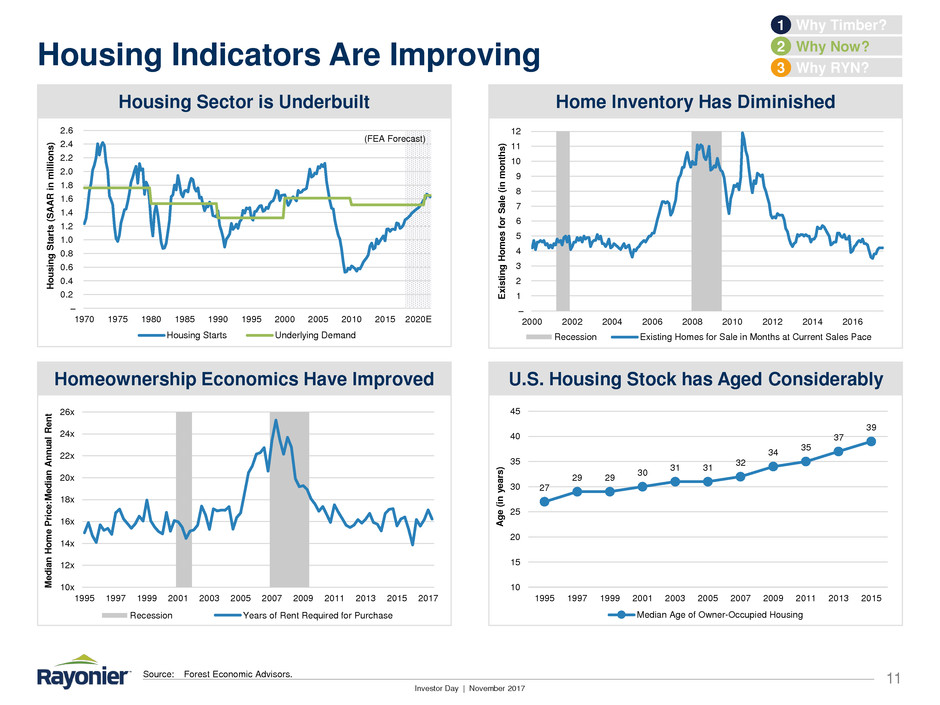
Investor Day | November 2017
–
0.2
0.4
0.6
0.8
1.0
1.2
1.4
1.6
1.8
2.0
2.2
2.4
2.6
1970 1975 1980 1985 1990 1995 2000 2005 2010 2015 2020E
Ho
usi
ng
S
ta
rts
(S
AA
R
in
m
illi
on
s)
Housing Starts Underlying Demand
(FEA Forecast)
Housing Indicators Are Improving
11
Housing Sector is Underbuilt
Source: Forest Economic Advisors.
Homeownership Economics Have Improved
Home Inventory Has Diminished
U.S. Housing Stock has Aged Considerably
Why Timber?1
Why Now?2
Why RYN?3
–
1
2
3
4
5
6
7
8
9
10
11
12
2000 20 2 2004 2006 2008 2010 2012 2014 2016
Ex
ist
ing
H
om
es
fo
r S
ale
(i
n
m
on
th
s)
Recession Existing Homes for Sale in Months at Current Sales Pace
27
29 29
30
31 31
32
34
35
37
39
10
15
20
25
30
35
40
45
1995 1997 1999 2001 2003 2005 2007 2009 2011 2013 2015
Ag
e (
in
yea
rs
)
Median Age of Owner-Occupied Housing
10x
12x
14x
16x
18x
20x
22x
24x
26x
1995 1997 1999 2001 2003 2005 2007 2009 2011 2013 2 15 2 17
Me
di
an
H
om
e P
ric
e:
Me
di
an
A
nn
ua
l Re
nt
Recession Years of Rent Required for Purchase

Investor Day | November 2017
–
2.5
5.0
7.5
10.0
12.5
–
500
1,000
1,500
2,000
2,500
St
arts
per 1,000 of Po
pulationAn
nu
al
Hou
sin
g St
arts
(0
00
s)
Single-Family Multi-Family FEA Single-Family FEA Multi-Family Starts per 1,000 of Population
Housing Starts Poised to Move Higher, Led by Single-Family
12
Historical and Projected Annual Housing Starts
Forest Economic Advisors projects that annual housing starts will reach 1.6 million by 2021,
led by single family construction.
Source: U.S. Census Bureau, Forest Economic Advisors.
1966 Trough
• 1.16mm Starts
• 779k SF Starts
• 5.9 per 1,000
1975 Trough
• 1.16mm Starts
• 892k SF Starts
• 5.4 per 1,000
1982 Trough
• 1.06mm Starts
• 663k SF Starts
• 4.6 per 1,000
1991 Trough
• 1.01mm Starts
• 840k SF Starts
• 4.0 per 1,000
2009 Trough
• 554k Starts
• 445k SF Starts
• 1.8 per 1,000
2017 / Current
• 1.2mm Starts
• 837k SF Starts
• 3.6 per 1,000
Why Timber?1
Why Now?2
Why RYN?3
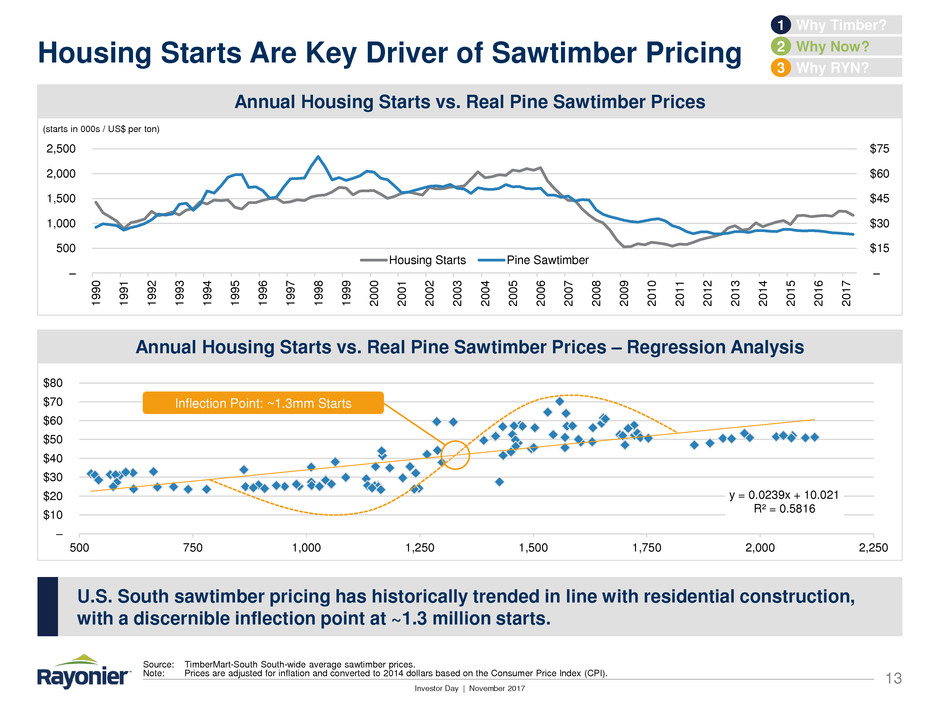
Investor Day | November 2017
y = 0.0239x + 10.021
R² = 0.5816
–
$10
$20
$30
$40
$50
$60
$70
$80
500 750 1,000 1,250 1,500 1,750 2,000 2,250
Housing Starts Are Key Driver of Sawtimber Pricing
13
Annual Housing Starts vs. Real Pine Sawtimber Prices
U.S. South sawtimber pricing has historically trended in line with residential construction,
with a discernible inflection point at ~1.3 million starts.
Source: TimberMart-South South-wide average sawtimber prices.
Note: Prices are adjusted for inflation and converted to 2014 dollars based on the Consumer Price Index (CPI).
Annual Housing Starts vs. Real Pine Sawtimber Prices – Regression Analysis
(starts in 000s / US$ per ton)
Inflection Point: ~1.3mm Starts
–
$15
$30
$45
$60
$75
–
500
1,000
1,500
2,000
2,500
1990 1991 1992 1993 1994 1995 1996 1997 1998 1999 2000 2001 2002 2003 2004 2005 2006 2007 2008 2009 2010 2011 2012 2013 2014 2015 2016 2017
Housing Starts Pine Sawtimber
Why Timber?1
Why Now?2
Why RYN?3
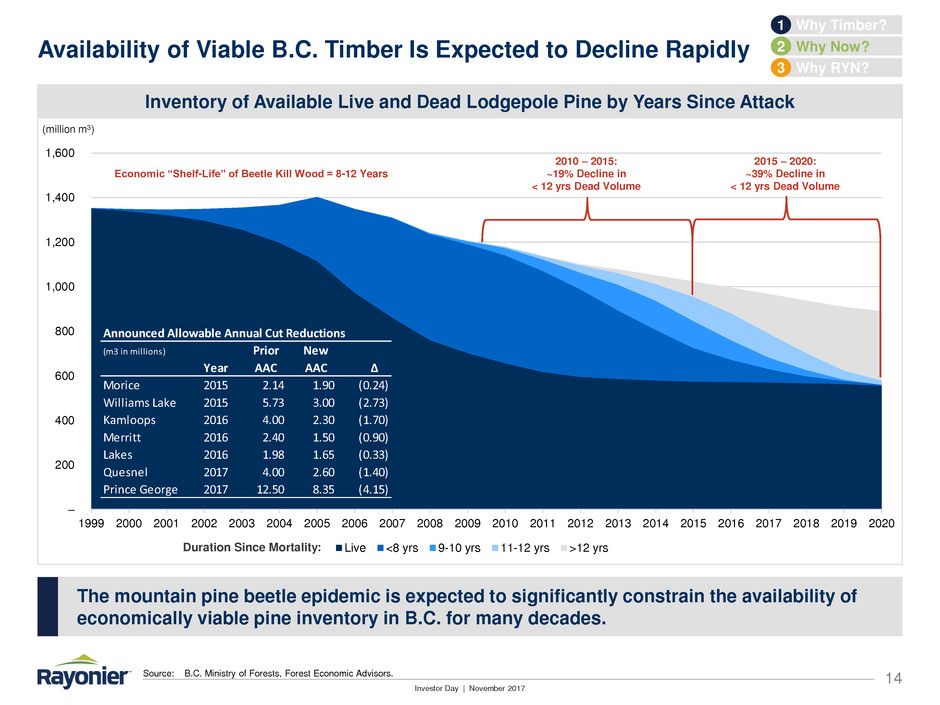
Investor Day | November 2017
–
200
400
600
800
1,000
1,200
1,400
1,600
1999 2000 2001 2002 2003 2004 2005 2006 2007 2008 2009 2010 2011 2012 2013 2014 2015 2016 2017 2018 2019 2020
Live <8 yrs 9-10 yrs 11-12 yrs >12 yrs
Availability of Viable B.C. Timber Is Expected to Decline Rapidly
14
Inventory of Available Live and Dead Lodgepole Pine by Years Since Attack
The mountain pine beetle epidemic is expected to significantly constrain the availability of
economically viable pine inventory in B.C. for many decades.
Source: B.C. Ministry of Forests, Forest Economic Advisors.
(million m3)
2015 – 2020:
~39% Decline in
< 12 yrs Dead Volume
2010 – 2015:
~19% Decline in
< 12 yrs Dead Volume
Economic “Shelf-Life” of Beetle Kill Wood = 8-12 Years
Duration Since Mortality:
Why Timber?1
Why Now?2
Why RYN?3
Announced Allowable Annual Cut Reductions
(m3 in millions) Prior New
Year AAC AAC Δ
Morice 2015 2.14 1.90 (0.24)
Williams Lake 2015 5.73 3.00 (2.73)
Kamloops 2016 4.00 2.30 (1.70)
Merritt 2016 2.40 1.50 (0.90)
Lakes 2016 1.98 1.65 (0.33)
Quesnel 2017 4.00 2.60 (1.40)
Prince George 2017 12.50 8.35 (4.15)

Investor Day | November 2017
Lumber Capacity in the U.S. South Continues to Expand
15
Active Mill Expansion in the U.S. South
Lumber production and capacity in the U.S. South is expected to grow significantly over the
next five years.
Source: Forisk Consulting, Rayonier Analysis, Forest Economic Advisors.
Production Growth Supports Incremental Capacity
(BBF)
Why Timber?1
Why Now?2
Why RYN?3
–
5
10
15
20
25
Capacity Production
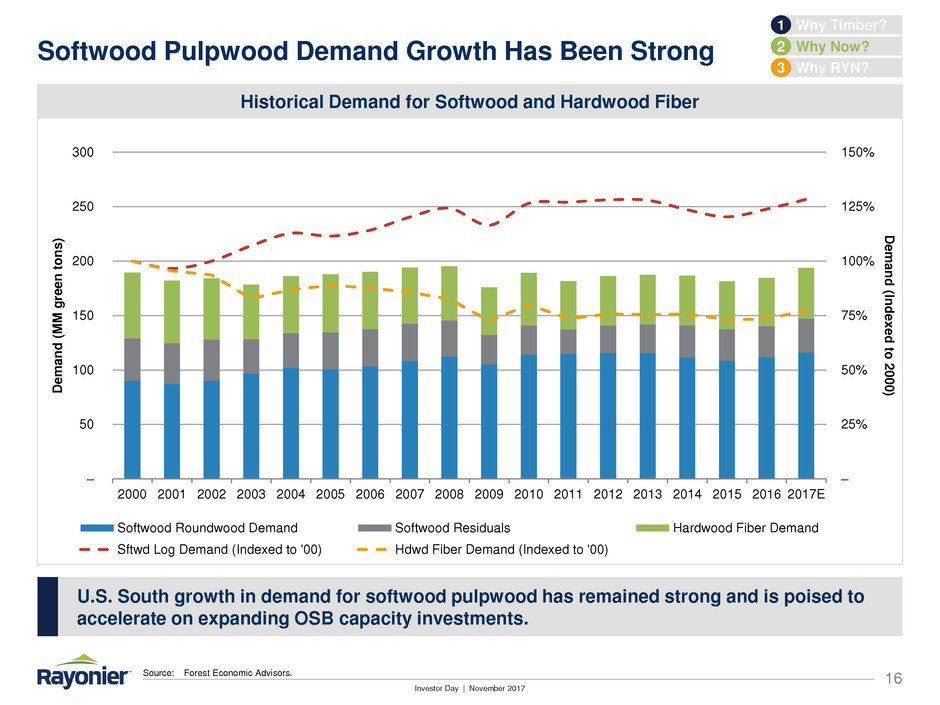
Investor Day | November 2017
Softwood Pulpwood Demand Growth Has Been Strong
16
Historical Demand for Softwood and Hardwood Fiber
U.S. South growth in demand for softwood pulpwood has remained strong and is poised to
accelerate on expanding OSB capacity investments.
Source: Forest Economic Advisors.
Why Timber?1
Why Now?2
Why RYN?3
–
25%
50%
75%
100%
125%
150%
–
50
100
150
200
250
300
2000 2001 2002 2003 2004 2005 2006 2007 2008 2009 2010 2011 2012 2013 2014 2015 2016 2017E
Dema
nd (Indexed
to 2000)Dema
nd
(M
M gre
en
to
ns
)
Softwood Roundwood Demand Softwood Residuals Hardwood Fiber Demand
Sftwd Log Demand (Indexed to '00) Hdwd Fiber Demand (Indexed to '00)

Investor Day | November 2017
Pulpwood Supports Composite Prices in Strong Markets
17
U.S. South-wide Average Stumpage Pricing
As sawtimber pricing has eroded in the U.S. South, increased pulpwood pricing has offset the
overall composite price decline in strong markets where Rayonier focuses its ownership.
Source: TimberMart-South.
Note: Composite pricing assumes 50% pulpwood, 30% chip-n-saw and 20% sawtimber.
Strong Markets Support Composite Pricing
Weaker Markets Hinder Composite Pricing
–
$5
$10
$15
$20
$25
$30
$35
$40
$45
$50
U.S. South Pulpwood U.S. South Sawtimber U.S. South Composite
–
$10
$20
$30
$40
$50
FL1 Pulpwood FL1 Sawtimber FL1 Composite
2005 – 2017: +2%
–
$10
$20
$30
$40
$50
MS1 Pulpwood MS1 Sawtimber MS1 Composite
Why Timber?1
Why Now?2
Why RYN?3
TimberMart-South South-wide Average
TMS FL1 Region
TMS MS1 Region
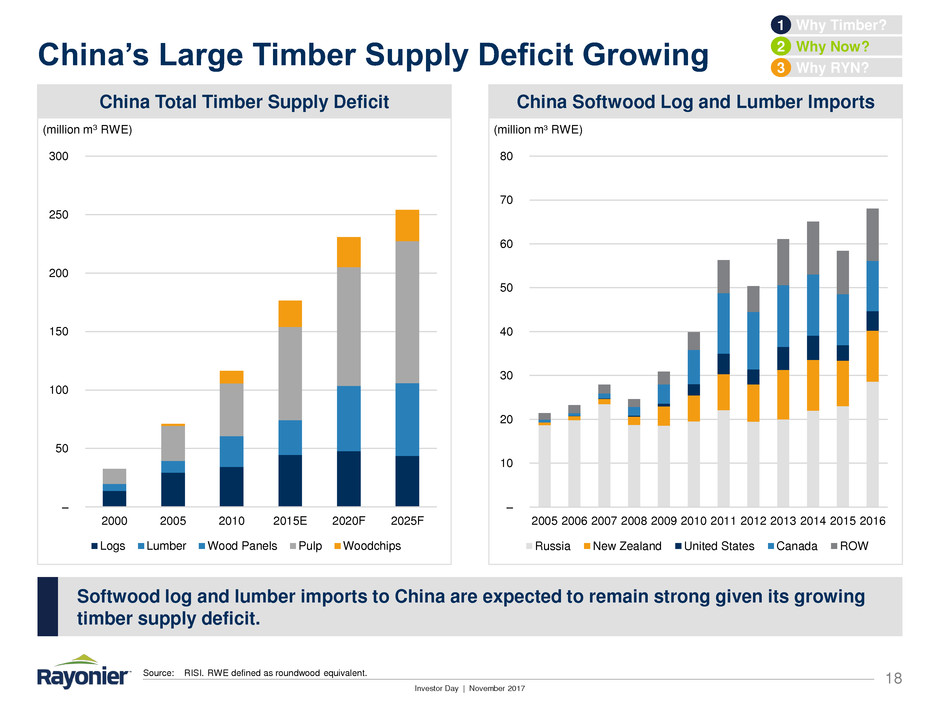
Investor Day | November 2017
China’s Large Timber Supply Deficit Growing
18
China Total Timber Supply Deficit China Softwood Log and Lumber Imports
Why Timber?1
Why Now?2
Why RYN?3
Source: RISI. RWE defined as roundwood equivalent.
Softwood log and lumber imports to China are expected to remain strong given its growing
timber supply deficit.
(million m3 RWE) (million m³ RWE)
–
50
100
150
200
250
300
2000 2005 2010 2015E 2020F 2025F
Logs Lumber Wood Panels Pulp Woodchips
–
10
20
30
40
50
60
70
80
2005 20 6 2007 08 2009 1 2011 12 2013 2014 2015 2016
Russia New Zealand United States Canada ROW

Investor Day | November 2017
Highly Productive, Geographically Diversified Timberlands
19
317
61
92
182
13
145
67 278 722
18
382
PACIFIC NORTHWEST
Acreage: 378k acres
Sustainable Yield: 1.4mm tons
U.S. SOUTH
Acreage: 1.9mm acres
Sustainable Yield: 5.9 – 6.3mm tons
NEW ZEALAND
Acreage: 429k acres
Sustainable Yield: 2.3mm tons
2.7 MILLION TOTAL ACRES
Why Timber?1
Why Now?2
Why RYN?3

Investor Day | November 2017
Rayonier is the Leading “Pure Play” Timber REIT
20
Peer Group EBITDA* Composition
(2016 – 2017 YTD)
Over the last two years, Rayonier has generated 73% of its EBITDA* from timber operations
(versus 49% for the peer group).
Note: Timberland REIT Peer Group comprised of WY, PCH and CTT. Figures reflect aggregate Timberland REIT Peer Group EBITDA for 2016 to Q3-2017 year-to-date,
excluding corporate expenses. Other includes real estate, manufacturing and other reported segments.
* Non-GAAP measure or pro forma item (see Appendix for definitions and RYN reconciliations).
Peer Group
2016 – 2017 YTD EBITDA*
Composition
Rayonier
2016 – 2017 YTD EBITDA*
Composition
Why Timber?1
Why Now?2
Why RYN?3
Timber
Segments
73%
Other
27%
Timber
Segments
49%
Other
51% 73%
47%
58%
69%
26%
10%
15%
31%
43%
27%
–
10%
20%
30%
40%
50%
60%
70%
80%
90%
100%
RYN WY PCH CTT
Timber Real Estate Manufacturing / Other

Investor Day | November 2017
Timberland vs. Wood Products Volatility
21
Historical Timber vs. Wood Products Segment EBITDA* Margins (1)
Timberland operations generally yield high EBITDA* margins with very low volatility relative
to wood products manufacturing.
(1) Based on aggregate U.S. timber segments EBITDA margin versus aggregate manufacturing segments EBITDA margin of Timber REIT peer group, including Rayonier,
Weyerhaeuser, legacy Plum Creek and Potlatch.
(2) Calculated as ratio of standard deviation to average.
* Non-GAAP measure or pro forma item (see Appendix for definitions and RYN reconciliations).
Margin Volatility / Coefficient of Variation (2)Average EBITDA* Margin (2004 – 2017 YTD)
(20%)
(10%)
–
10%
20%
30%
40%
2004 2005 2006 2007 2008 2009 2010 2011 2012 2013 2014 2015 2016 Q3-17
YTD
Timber Wood Products
33.2%
6.0%
–
10%
20%
30%
40%
Timber Wood Products
10.9%
161.2%
–
50%
100%
150%
200%
Timber Wood Products
Why Timber?1
Why Now?2
Why RYN?3

Investor Day | November 2017
Rayonier Portfolio Highlights
22
Sector-Leading U.S. South EBITDA per Ton
(1) Based on Rayonier estimates; assumes current portfolio with no acquisitions or divestitures.
Improving Harvest Profile (1)
Sector-Leading HBU Value Realizations
Unique Exposure to China Export Market
Why Timber?1
Why Now?2
Why RYN?3
–
2.0
4.0
6.0
8.0
10.0
12.0
2015-2017 2018-2022 2023-2032
Historical & Projected Harvest Volumes (tons in MMs)
Southern Pacific Northwest New Zealand
–
$2
$4
$6
$8
$10
$12
$14
$16
$18
$20
Rayonier Weyerhaeuser Potlatch CatchMark
U.S. South: LTM (Q3 2017) EBITDA per Ton
–
$500
$1,000
$1,500
$2,000
$2,500
$3,000
Rayonier Weyerhaeuser Potlatch CatchMark
Real Estate Value per Acre Sold (2016 – Q3 2017)
–
5%
10%
15%
20%
25%
30%
New Zealand Pacific
Northwest
Southern Total Rayonier
% of 2017E Volume Sold into China Market

Investor Day | November 2017
Prudent Capital Structure and Financial Policy
23
Credit Highlights & Ratio Targets
Rayonier has a strong, investment grade credit profile with significant asset coverage.
Current Credit Ratings
S&P: BBB- / Stable
Moody’s: Baa3 / Stable
Credit Highlights
Strong Adj. EBITDA* margins
High EBITDA-to-FCF conversion
Significant asset coverage
3.3% weighted avg. cost of debt / 95% fixed
Credit Ratio Targets
Committed to maintaining an investment grade
credit profile
Target credit metrics include:
̶ Net Debt / Adj. EBITDA*: ~4.5x
̶ Net Debt / Asset Value: < 30%
(1) Enterprise value based on market capitalization plus net debt as of 9/30/2017.
* Non-GAAP measure or pro forma item (see Appendix for definitions and RYN reconciliations).
Why Timber?1
Why Now?2
Why RYN?3
Capitalization & Maturity Profile
($ in millions) 9/30/2017
Total Debt $1,033.4
(–) Cash (104.1)
Net Debt $929.3
Credit Data
LTM Adjusted EBITDA* $265.4
LTM Interest Expense $34.2
Credit Statistics
Net Debt / LTM Adjusted EBITDA* 3.5x
LTM Adj. EBITDA* / Interest Expense 7.8x
Net Debt / Enterprise Value (1) 20%
–
$100
$200
$300
$400
2018 2019 2020 2021 2022 2023 2024 2025 2026 2027+

Investor Day | November 2017
Nimble Approach to Capital Allocation
24
Acquired ~$800
million of
timberlands since
spin-off
Acquisitions
complementary to
age-class profile
Improved portfolio
site index and
inventory stocking
~$34 million
invested annually
in silviculture and
regeneration
Capital focused
on highest IRR
opportunities
Targeted
investments to
unlock HBU value
Invest in Our
Business
Timberland
Acquisitions
Share Buybacks/
Equity Issuance
$101 million of
stock buybacks
@ $23.76/share
$160 million of
equity issuance
@ $27.75/share
Focused on
generating NAV
accretion
Dividend of $1.00
per share since
Q4 2014
Funded from
recurring timber
and real estate
operations
Large Dispositions*
excluded from
CAD*
Dividends
Restructured
$155 million of
New Zealand debt
95% of debt fixed;
3.3% avg. rate
Maintained
investment grade
rating with higher
debt threshold
Manage Our
Balance Sheet
$34MM(1)
annually for
silviculture
$800MM
acquisitions
since spin-off
$59MM
net share issuance
since spin-off
3.2% yield(2)
$1.00 per share
annual dividend
3.3% rate
average
debt cost
(1) Represents average annual investment in silviculture and replanting from 2013-2016.
(2) Based on share price of $31.18 as of 11/7/2017.
* Non-GAAP measure or pro forma item (see Appendix for definitions and RYN reconciliations).
Why Timber?1
Why Now?2
Why RYN?3

Investor Day | November 2017
Deconstructing Timberland Returns
25
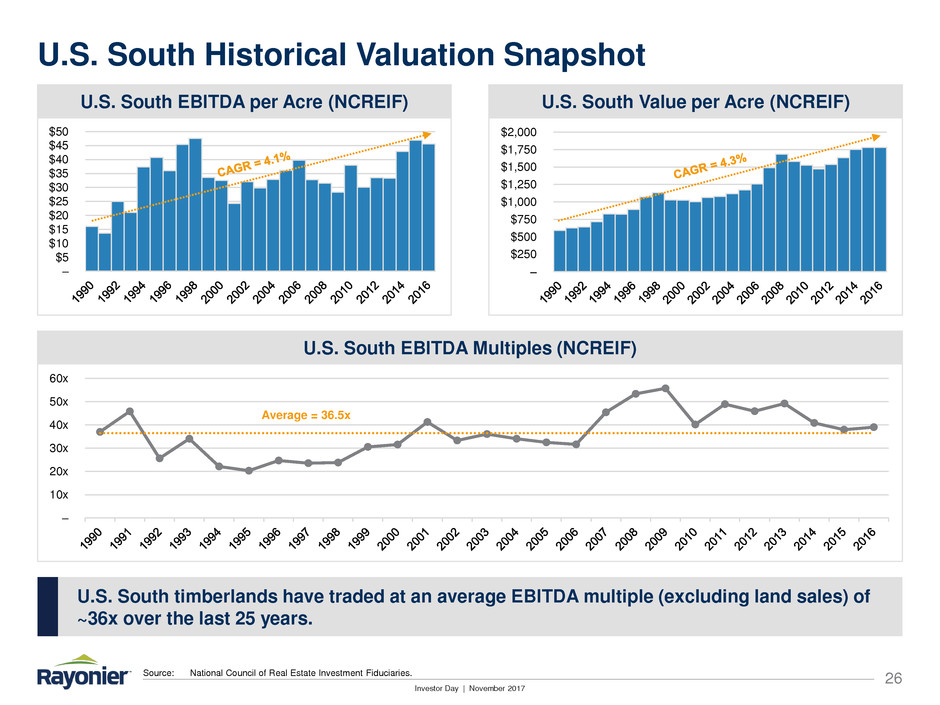
Investor Day | November 2017
–
10x
20x
30x
40x
50x
60x
–
$250
$500
$750
$1,000
$1,250
$1,500
$1,750
$2,000
U.S. South Historical Valuation Snapshot
26
U.S. South EBITDA per Acre (NCREIF)
U.S. South timberlands have traded at an average EBITDA multiple (excluding land sales) of
~36x over the last 25 years.
Source: National Council of Real Estate Investment Fiduciaries.
U.S. South Value per Acre (NCREIF)
U.S. South EBITDA Multiples (NCREIF)
Average = 36.5x
–
$5
$10
$15
$20
$25
$30
$35
$40
$45
$50

Investor Day | November 2017
(10.0%)
(5.0%)
–
5.0%
10.0%
15.0%
20.0%
25.0%
1990 1991 1992 1993 1994 1995 1996 1997 1998 1999 2000 2001 2002 2003 2004 2005 2006 2007 2008 2009 2010 2011 2012 2013 2014 2015 2016
EBITDA Return Appreciation Return
Historical Components of U.S. South Timberland Returns
27
NCREIF South Historical Returns
U.S. South timberlands have historically been bid to a sub-3% EBITDA cap rate and have
generally exhibited a negative spread to treasuries.
Source: National Council of Real Estate Investment Fiduciaries.
NCREIF South Historical EBITDA Returns vs. 10-Year Treasury
20-Year 10-Year
Avg. EBITDA Return 2.9% 2.3%
Avg. Appreciation Return 4.1% 2.9%
–
1.0%
2.0%
3.0%
4.0%
5.0%
6.0
7.
8
9.0%
1990 1991 1992 1993 1994 1995 1996 1997 1998 1999 2000 2001 2002 2003 2004 2005 2006 2007 2008 2009 2010 2011 2012 2013 2014 2015 2016
EBITDA Return 10-year UST
20-Year 10-Year
Avg. EBITDA Return 2.9% 2.3%
Avg. Spread to 10-yr UST (1.1%) (0.5%)
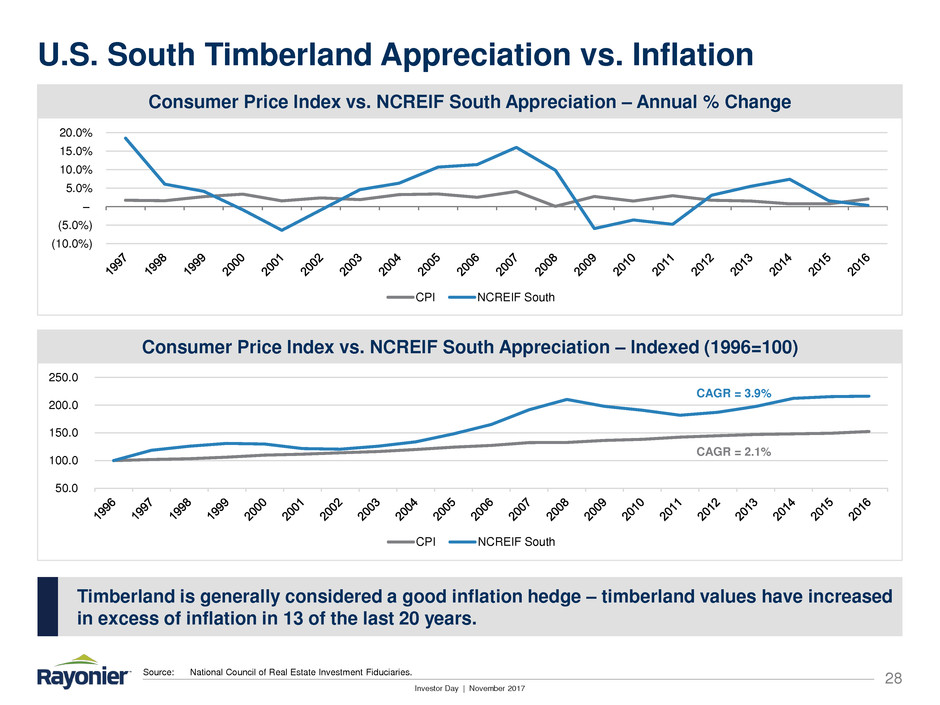
Investor Day | November 2017
50.0
100.0
150.0
200.0
250.0
CPI NCREIF South
U.S. South Timberland Appreciation vs. Inflation
28
Consumer Price Index vs. NCREIF South Appreciation – Annual % Change
Timberland is generally considered a good inflation hedge – timberland values have increased
in excess of inflation in 13 of the last 20 years.
Source: National Council of Real Estate Investment Fiduciaries.
Consumer Price Index vs. NCREIF South Appreciation – Indexed (1996=100)
CAGR = 3.9%
CAGR = 2.1%
(1 . %)
(5.0%)
–
5.0%
10.0%
15.0%
20.0%
CPI NCREIF South
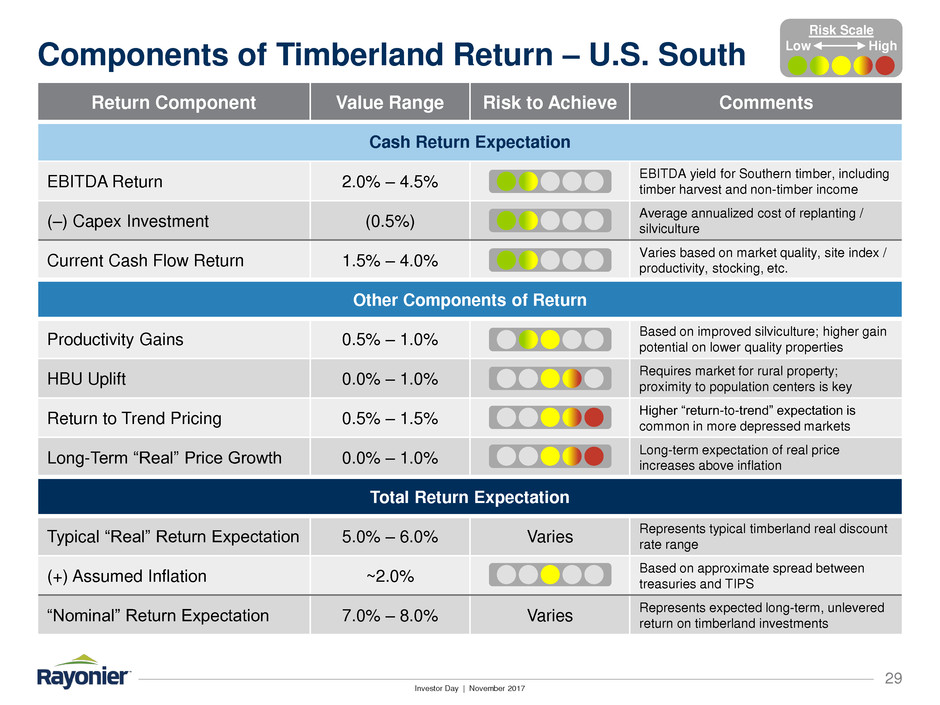
Investor Day | November 2017
Components of Timberland Return – U.S. South
29
Return Component Value Range Risk to Achieve Comments
Cash Return Expectation
EBITDA Return 2.0% – 4.5%
EBITDA yield for Southern timber, including
timber harvest and non-timber income
(–) Capex Investment (0.5%)
Average annualized cost of replanting /
silviculture
Current Cash Flow Return 1.5% – 4.0%
Varies based on market quality, site index /
productivity, stocking, etc.
Other Components of Return
Productivity Gains 0.5% – 1.0%
Based on improved silviculture; higher gain
potential on lower quality properties
HBU Uplift 0.0% – 1.0%
Requires market for rural property;
proximity to population centers is key
Return to Trend Pricing 0.5% – 1.5%
Higher “return-to-trend” expectation is
common in more depressed markets
Long-Term “Real” Price Growth 0.0% – 1.0%
Long-term expectation of real price
increases above inflation
Total Return Expectation
Typical “Real” Return Expectation 5.0% – 6.0% Varies
Represents typical timberland real discount
rate range
(+) Assumed Inflation ~2.0%
Based on approximate spread between
treasuries and TIPS
“Nominal” Return Expectation 7.0% – 8.0% Varies
Represents expected long-term, unlevered
return on timberland investments
Risk Scale
Low High

Investor Day | November 2017
60
65
70
75
80
85
S
it
e
In
d
e
x
2
5
(f
e
e
t)
Planting Year
Productivity is a Key Driver of Timberland Value
Rayonier Loblolly Pine Site Index25 (feet)
Higher site index properties generate greater harvest yields and a more valuable product mix.
Improving site index by 10 feet over a 25-year harvest rotation implies ~1% annual productivity gain.
(1) First physical site index measurement taken at age 11.
(2) Growth and yield predictions based on PMRC 1996 (Loblolly PMRC TR-1996-1 and Slash PMRC TR-1996-3) with FMRC Fastlob 3.0 Fertilizer response equations.
Assumes mix of plantation / hardwood acreage and loblolly / slash species based on Rayonier portfolio averages.
Harvest Volume Increases with Site Index (2)
Product Mix Improves with Site Index (2)
Recently
measured
stands (1)
30
Recently
harvested
stands
RYN avg. measured
loblolly site index = 73
–
20%
40%
60%
80%
100%
60 65 70 75 80 85
Pine ST Pine CNS Pine PW Hardwood
–
1.0
2.0
3.0
4.0
5.0
6.0
60 65 70 75 80 85
To
ns
/ A
cre
/ Y
ea
r
Site Index25 (feet)
Transition 65 to 75 over 25 years =
1.1% productivity CAGR
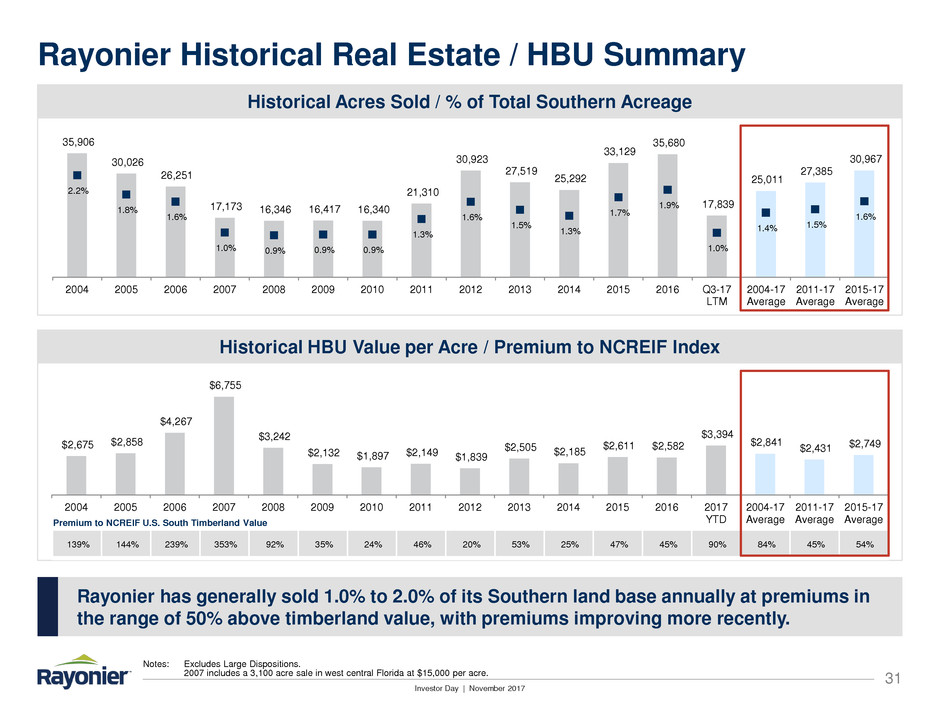
Investor Day | November 2017
35,906
30,026
26,251
17,173 16,346 16,417 16,340
21,310
30,923
27,519
25,292
33,129
35,680
17,839
25,011
27,385
30,967
2.2%
1.8%
1.6%
1.0% 0.9% 0.9% 0.9%
1.3%
1.6%
1.5%
1.3%
1.7%
1.9%
1.0%
1.4% 1.5%
1.6%
2004 2005 2006 2007 2008 2009 2010 2011 2012 2013 2014 2015 2016 Q3-17
LTM
2004-17
Average
2011-17
Average
2015-17
Average
$2,675 $2,858
$4,267
$6,755
$3,242
$2,132 $1,897 $2,149 $1,839
$2,505 $2,185
$2,611 $2,582
$3,394
$2,841
$2,431 $2,749
2004 2005 2006 2007 2008 2009 2010 2011 2012 2013 2014 2015 2016 2017
YTD
2004-17
Average
2011-17
Average
2015-17
Average
Rayonier Historical Real Estate / HBU Summary
31
Historical Acres Sold / % of Total Southern Acreage
Rayonier has generally sold 1.0% to 2.0% of its Southern land base annually at premiums in
the range of 50% above timberland value, with premiums improving more recently.
Notes: Excludes Large Dispositions.
2007 includes a 3,100 acre sale in west central Florida at $15,000 per acre.
Historical HBU Value per Acre / Premium to NCREIF Index
139% 144% 239% 353% 92% 35% 24% 46% 20% 53% 25% 47% 45% 90% 84% 45% 54%
Premium to NCREIF U.S. South Timberland Value

Investor Day | November 2017
Illustrative HBU Economics
32
Example: 1 Million Acre U.S. South Portfolio
A well-designed HBU program should be able to generate roughly 0.5% to 1.0% of incremental
return relative to underlying timberland returns (depending on the quality of HBU product).
(1) Based on NCREIF U.S. South Timberland index average value per acre as of Q3 2017.
(2) Assumes overhead costs of 10% of sales.
(3) Assumes additional timberlands acquired to replace acreage sold as HBU.
(4) Represents average Real Estate segment sales price per acre for 2016 – YTD 2017.
HBU Incremental Return Sensitivity Analysis
Peer Group Real Estate Prices (2016 – YTD 2017) (4)
$2,837
$2,076
$1,602
$1,838
–
$500
$1,000
$1,500
$2,000
$2,500
$3,000
Rayonier Weyerhaeuser Potlatch CatchMark
($ in 000s, excepts per acre values)
Sales Pace / Premium 1.0% / 50.0% 1.5% / 75.0%
Illustrative Asset Profile
U.S. South Portfolio Acres (000s) 1,000 1,000
Timberland Value per Acre (1) $1,777 $1,777
Implied Total Asset Value $1,777,000 $1,777,000
Implied HBU Inputs
# of Acres Sold Annually 10,000 15,000
Implied HBU Price per Acre $2,666 $3,110
HBU Premium per Acre $889 $1,333
HBU Contribution to Return
HBU Sales Revenue $26,655 $46,646
(–) Real Estate Overhead Costs (2) (2,666) (4,665)
Implied Adjusted EBITDA $23,990 $41,982
(–) Acquire Replacement Timberlands (3) (17,770) (26,655)
Residual Cash Flow $6,220 $15,327
Residual Cash Flow / Total Asset Value 0.4% 0.9%
(% incremental return)
Premium to Timberland Value
0.4% – 25% 50% 75% 100%
0.50% (0.1%) 0.1% 0.2% 0.3% 0.4%
% of 0.75% (0.1%) 0.1% 0.3% 0.4% 0.6%
Acreage 1.00% (0.1%) 0.1% 0.4% 0.6% 0.8%
Sold 1.25% (0.1%) 0.2% 0.4% 0.7% 1.0%
1.50% (0.2%) 0.2% 0.5% 0.9% 1.2%

Investor Day | November 2017
Deconstructing Timberland Returns – Illustrative Acquisitions
33
Illustrative Acquisition Scenario A – Low Productivity / Bottom Quartile Market
(1) Based on TimberMart-South 2016 regional average composite stumpage price assuming mix of 50% pulpwood, 30% chip-n-saw and 20% sawtimber.
(2) Growth and yield predictions based on PMRC 1996 (Loblolly PMRC TR-1996-1 and Slash PMRC TR-1996-3) with FMRC Fastlob 3.0 Fertilizer response equations.
Assumes mix of plantation / hardwood acreage and loblolly / slash species based on Rayonier portfolio averages.
(3) Assumes non-timber income roughly offsets timber management costs for illustration purposes.
Illustrative Acquisition Scenario B – High Productivity / Top Quartile Market
Assumed Portfolio Profile
Location MS-1
Composite Stumpage Price (1) $11.30
Site Index 65
Volume per Acre per Year (2) 3.2
Implied EBITDA per Acre (3) $36
Assumed Value per Acre $1,600
Assumed Portfolio Profile
Location GA-2
Composite Stumpage Price (1) $19.25
Site Index 80
Volume per Acre per Year (2) 5.0
Implied EBITDA per Acre (3) $96
Assumed Value per Acre $2,400
(0.5%) 0.5%
0.5%
1.0%
4.0%
5.5%
–
1.0%
2.0%
3.0%
4.0%
5.0%
6.0%
EBITDA
Return
(Capex) Productivity
Gains
HBU
Uplift
Real Price
Increases
Real
Return
Expected Components of Return
(0.5%)
1.0%
0.5%
2.2%
2.3%
5.5%
–
1.0%
2.0%
3.0%
4.0%
5.0%
6.0%
EBITDA
Return
(Capex) Productivity
Gains
HBU
Uplift
Real Price
Increases
Real
Return
Expected Components of Return
33%
27%
40%
Return Components (% of Total)
Cash Yield Productivity / HBU Price Increases
64%
18%
18%
Return Components (% of Total)
Cash Yield Productivity / HBU Price Increases
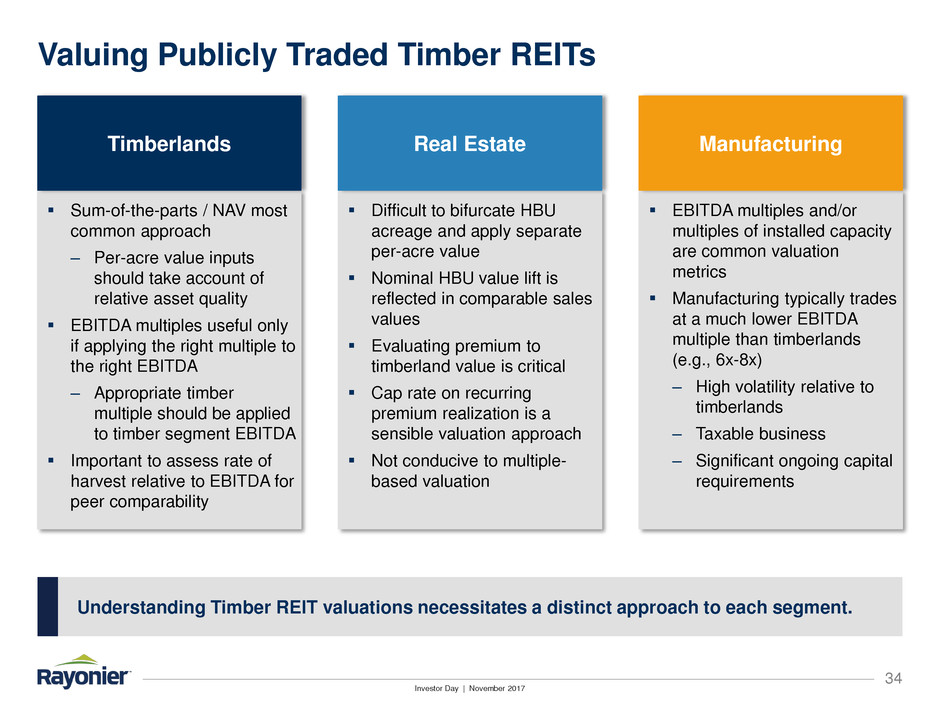
Investor Day | November 2017
Valuing Publicly Traded Timber REITs
Sum-of-the-parts / NAV most
common approach
– Per-acre value inputs
should take account of
relative asset quality
EBITDA multiples useful only
if applying the right multiple to
the right EBITDA
– Appropriate timber
multiple should be applied
to timber segment EBITDA
Important to assess rate of
harvest relative to EBITDA for
peer comparability
34
Timberlands
Understanding Timber REIT valuations necessitates a distinct approach to each segment.
Difficult to bifurcate HBU
acreage and apply separate
per-acre value
Nominal HBU value lift is
reflected in comparable sales
values
Evaluating premium to
timberland value is critical
Cap rate on recurring
premium realization is a
sensible valuation approach
Not conducive to multiple-
based valuation
Real Estate
EBITDA multiples and/or
multiples of installed capacity
are common valuation
metrics
Manufacturing typically trades
at a much lower EBITDA
multiple than timberlands
(e.g., 6x-8x)
– High volatility relative to
timberlands
– Taxable business
– Significant ongoing capital
requirements
Manufacturing

Investor Day | November 2017
18.6x
25.4x
19.7x 20.0x
26.4x
30.8x
27.6x
30.8x
–
10.0x
20.0x
30.0x
40.0x
Rayonier Weyerhaeuser Potlatch CatchMark
EBITDA excl. Manufacturing EBITDA excl. Manufacturing & Real Estate
Timber REIT Enterprise Value / EBITDA Multiples
35
Enterprise Value / LTM Q3-17 EBITDA Multiples (1)
Adjusting for manufacturing assets and real estate sales, the Timber REITs currently trade at
a range of 26x to 31x “timber segments” EBITDA.
(1) Enterprise Value based on market capitalization (shares outstanding x share price) plus net debt; share prices as of 11/7/17; shares outstanding and net debt as of 9/30/17.
(2) Adjusted Enterprise Value excludes Manufacturing assets at 7x LTM Q3-17 EBITDA.
(3) New Zealand land sales EBITDA of $23.8 million in Q2 2017 reclassified to Real Estate for purposes of multiple calculation.
(4) Multiple of EBITDA excluding Manufacturing EBITDA and Real Estate EBITDA (i.e., Timber segments only).
Adj. Enterprise Value (excl. Manufacturing @ 7x EBITDA) / LTM Q3-17 EBITDA Multiples (2)
(4)
(3)
18.6x
16.9x
14.8x
20.0x
–
5
10.0x
15.0x
20.0x
25.0x
Rayonier Weyerhaeuser Potlatch CatchMark
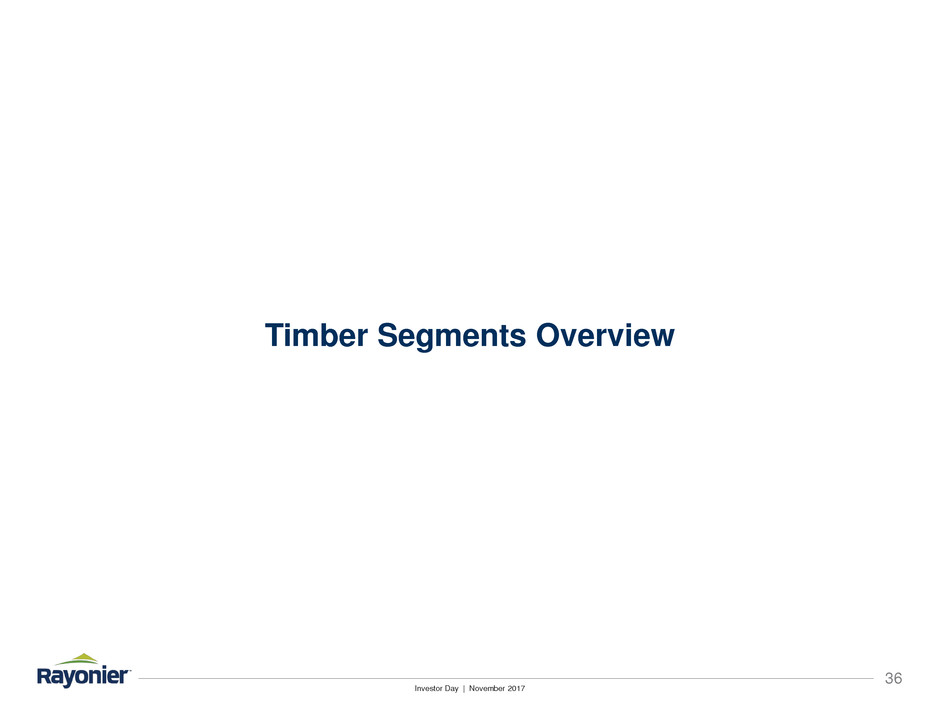
Investor Day | November 2017
Timber Segments Overview
36

Investor Day | November 2017
Southern Timber – Portfolio Overview
37
Highlights / Location
Source: U.S. Dept. of Agriculture, Society of American Foresters Journal of Forestry.
(1) Site index reflects the average height of the dominant and codominant trees at a base age of 25 (U.S. South).
(2) Age class profile as of 9/30/16 per 2016 10-K.
* Non-GAAP measure (see Appendix for definitions and RYN reconciliations).
Strong Productivity Characteristics
Balanced Age Class Profile (2)
▪ Acreage: 1.9 million acres
▪ Sustainable Yield: 5.9 – 6.3 million tons
▪ Planted / Plantable: 68%
▪ Average Site Index: 73 feet at age 25(1)
▪ 2016 EBITDA*: $93 million
▪ YTD Q3 2017 EBITDA*: $72 million
▪ Sustainable Forestry Initiative Certification
–
50
100
150
200
250
300
0-4 5-9 10-14 15-19 20-24 25+ Natural
Pine
Ac
re
s i
n 0
00
s
Age Class in Years
–
15
30
45
60
75
Southern Yellow
Pine Regional Avg.
Industrially-Managed
SYP Average
Rayonier
SYP Average
Sit
e I
nd
ex
in
Fe
et
(1
)

Investor Day | November 2017
Change in Consumption by Region: 2005-2014
Recession-induced demand declines have led to large drops in consumption for most areas
Differences in consumption declines have caused regional market performance to vary
Timberland portfolio performance will be influenced by geographic distribution
Consumption & Inventory Changes Vary Across U.S. South
38
Change in Inventory by Region: 2005-2014
Source: USDA FIA Timber Product Output; University of Georgia, Wood Demand Report;
Rayonier estimates.
Source: USDA FIA data; Rayonier analysis.

Investor Day | November 2017
–
$5
$10
$15
$20
$25
FL
-1
G
A-
2
SC-
2
N
C
-2
FL
-2
LA-
1
V
A
-2
V
A
-1
LA-
2
A
L-
2
TX-
1
SC-
1
GA
-1
TX-
2
M
S
-2
A
L-
1
A
R
-1
N
C
-1
AR-
2
M
S
-1
TN-
1
TN-
2
U.S. South Average
RYN Concentrated in Strongest U.S. South Markets
39
Approximately 62% of Rayonier’s Southern timberlands are located in the top three markets
(ranked by TimberMart-South composite stumpage pricing).
Source: TimberMart-South.
Note: Composite pricing assumes mix of 50% pulpwood, 30% chip-n-saw and 20% sawtimber.
TMS 2016 Composite Price Quartile Rankings
Supply / demand dynamics are highly localized, as logs generally travel less than 100 miles
Timber consumption vs. inventory growth remains much more tensioned in Coastal Atlantic markets
TMS 2016 Composite Price by Region
Top 3
Markets 62% of RYN Southern Lands in Top 3 Markets

Investor Day | November 2017
Rayonier Leads the Sector In U.S. South EBITDA* / Ton
40
U.S. South EBITDA* / Ton
Rayonier’s sector-leading EBITDA* per Ton has increased by over 20% since 2012, while its
rate of harvest has remained relatively stable.
Source: WY figures pro forma for PCL combination. EBITDA, harvest volume and acreage data for all peers based on public filings. Per acre data calculated based on estimated
average acres for each year (i.e., average of year-end and prior year-end acres), adjusted for major acquisitions/dispositions (i.e., pro-rated from date of transaction).
* Non-GAAP measure or pro forma item (see Appendix for definitions and RYN reconciliations).
U.S. South Rate of Harvest U.S. South EBITDA* / Acre
EBITDA* per ton best captures profitability per unit of sales
EBITDA* per acre can be misleading due to differential rates of harvest
($ per ton harvested) (tons per acre per year) ($ per acre)
$8
$10
$12
$14
$16
$18
$20
2012 2013 2014 2015 2016 Q3-17
LTM
RYN WY PCH CTT
1.0
1.5
2.0
2.5
3.0
3.5
4.0
4.5
5.0
2012 2013 2014 2015 2016 Q3-17
LTM
RYN WY PCH CTT
$30
$35
$40
$45
$50
$55
$60
$65
$70
2012 2013 2014 2015 2016 Q3-17
LTM
RYN WY PCH CTT
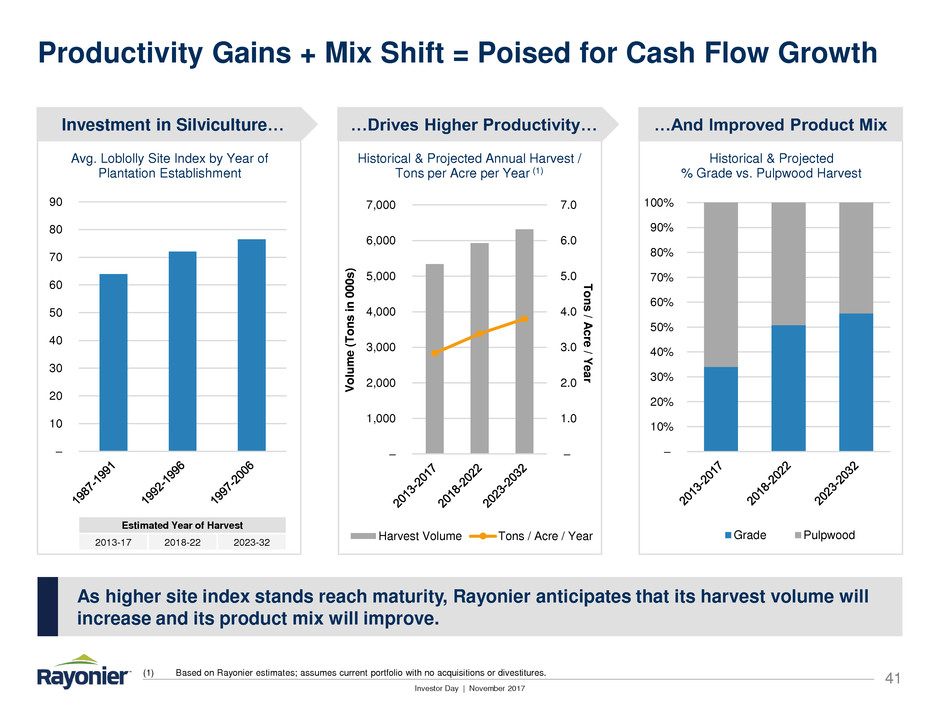
Investor Day | November 2017
–
10
20
30
40
50
60
70
80
90
Productivity Gains + Mix Shift = Poised for Cash Flow Growth
41
Investment in Silviculture…
As higher site index stands reach maturity, Rayonier anticipates that its harvest volume will
increase and its product mix will improve.
(1) Based on Rayonier estimates; assumes current portfolio with no acquisitions or divestitures.
…Drives Higher Productivity… …And Improved Product Mix
Avg. Loblolly Site Index by Year of
Plantation Establishment
Historical & Projected Annual Harvest /
Tons per Acre per Year (1)
Historical & Projected
% Grade vs. Pulpwood Harvest
Estimated Year of Harvest
2013-17 2018-22 2023-32
–
10%
20%
30%
40%
50%
60%
70%
80%
90%
100%
Grade Pulpwood
–
1.0
2.0
3.0
4.0
5.0
6.0
7.0
–
1,000
2,000
3,000
4,000
5,000
6,000
7,000
T
o
n
s
/ A
c
re
/ Y
e
a
r
Volum
e
(Ton
s
in
0
0
0
s
)
Harvest Volume Tons / Acre / Year

Investor Day | November 2017
–
0.2
0.4
0.6
0.8
1.0
1.2
1.4
2012 2013 2014 2015 2016
U.S. South Exports to China and India
Growing U.S. South Export Demand
42
Export Volumes by U.S. South Port
Exports to China and India from the U.S. South have grown considerably, and Rayonier is well
positioned to capitalize on this trend given its proximity to ports.
Source: GATS
(1) 2017E is based on data from January through August, annualized.
U.S. South Exports to China and India
(million green tons)
2017E(1)
U.S. South Exports to China and India (in Green Tons)
Port 2012 2013 2014 2015 2016 2017YTD 2017E
Charleston, SC 16,332 90,400 150,182 78,312 247,913 203,208 304,812
Savannah, GA 66,181 157,220 375,326 209,269 213,083 189,729 284,593
Wilmington, NC 25,286 70,409 78,417 42,756 138,323 188,070 282,105
Jacksonville, FL - 1,883 72,256 62,902 92,651 138,663 207,995
Norfolk, VA 19,199 10,042 22,499 12,336 33,302 31,292 46,938
Mobile, AL 930 650 5,778 2,018 1,407 19,578 29,367
Total 127,928 330,604 704,457 407,592 726,680 770,540 1,155,810

Investor Day | November 2017
Pacific Northwest Timber – Portfolio Overview
43
Highlights / Location
Source: U.S. Dept. of Agriculture, Society of American Foresters Journal of Forestry.
(1) Site index reflects the average height of the dominant and codominant trees at a base age of 50 (Pacific Northwest).
(2) Age class profile as of 9/30/16 per 2016 10-K.
* Non-GAAP measure (see Appendix for definitions and RYN reconciliations).
Strong Productivity Characteristics
Improving Age Class Profile (2)
▪ Acreage: 378,000 acres
▪ Sustainable Yield: 1.4 million tons
▪ Planted / Plantable: 78%
▪ Average Site Index: 109 feet at age 50(1)
▪ 2016 EBITDA*: $21 million
▪ YTD Q3 2017 EBITDA*: $23 million
▪ Sustainable Forestry Initiative Certification
–
10
20
30
40
50
60
70
80
90
0-9 10-19 20-29 30-39 40+
Ac
re
s i
n 0
00
s
Age Class in Years
(1
)
–
25
50
75
100
125
Douglas-fir
Regional Avg.
Industrially-Managed
Douglas-fir Avg.
Rayonier
Douglas-fir Avg.
Sit
e I
nd
ex
in
F
ee
t

Investor Day | November 2017
Diverse Species and End Markets
44
Pacific Northwest Inventory by Species
Rayonier’s Pacific Northwest portfolio provides diversity of products and end-markets.
Volume by Destination (YTD 2017)
Douglas-fir
55%
Hemlock
40%
Other
5%
Domestic
74%
Export
26%

Investor Day | November 2017
–
$100
$200
$300
$400
$500
$600
$700
$800
–
2.0
4.0
6.0
8.0
10.0
12.0
14.0
West Coast Lumber Production Log Exports (Lumber Basis)
Douglas-fir Log Price (Log Lines Region #1 - #2 Sawlog) Western Hemlock Log Price (Log Lines Region #1 - #2 Sawlog)
Pacific Northwest Demand and Pricing Have Recovered
45
Pacific Northwest Log Demand & Pricing
Pacific Northwest log prices have recovered to above pre-recession levels driven by
increased export demand.
Source: Forest Economic Advisors, RISI.
Note: Log exports converted to lumber basis assuming 2.35 recovery rate.
(BBF) ($ per MBF)

Investor Day | November 2017
Rayonier’s Northwest EBITDA* / Ton Is Improving
46
Northwest EBITDA* / Ton
Rayonier’s Northwest EBITDA* per ton has been below the peer group due to its historical
proportion of hemlock volume (vs. Doug-fir) and, more recently, due to its reduced rate of harvest.
Source: WY EBITDA based on historical public filings, excludes PCL contribution in 2012-15; Pope EBITDA based on historical public filings. Volume and acreage data for all peers
based on historical public filings; assumes 8.0 tons per MBF for Pope.
* Non-GAAP measure or pro forma item (see Appendix for definitions and RYN reconciliations).
Northwest Rate of Harvest Northwest EBITDA* / Acre
Following November 2014 announcements, Rayonier reduced its rate of harvest in the Northwest
EBITDA* per ton and EBITDA* per acre both declined as a result, but have improved since
($ per ton harvested) (tons per acre per year) ($ per acre)
$10
$20
$30
$40
$50
$60
2012 2013 2014 2015 2016 Q3-17
LTM
RYN WY Pope
1.0
1.5
2.0
2.5
3.0
3.5
4.0
4.5
5.0
5.5
2012 2013 2014 2015 2016 Q3-17
LTM
RYN WY Pope
$0
$50
$100
$150
$200
$250
2012 2013 2014 2015 2016 Q3-17
LTM
RYN WY Pope
–
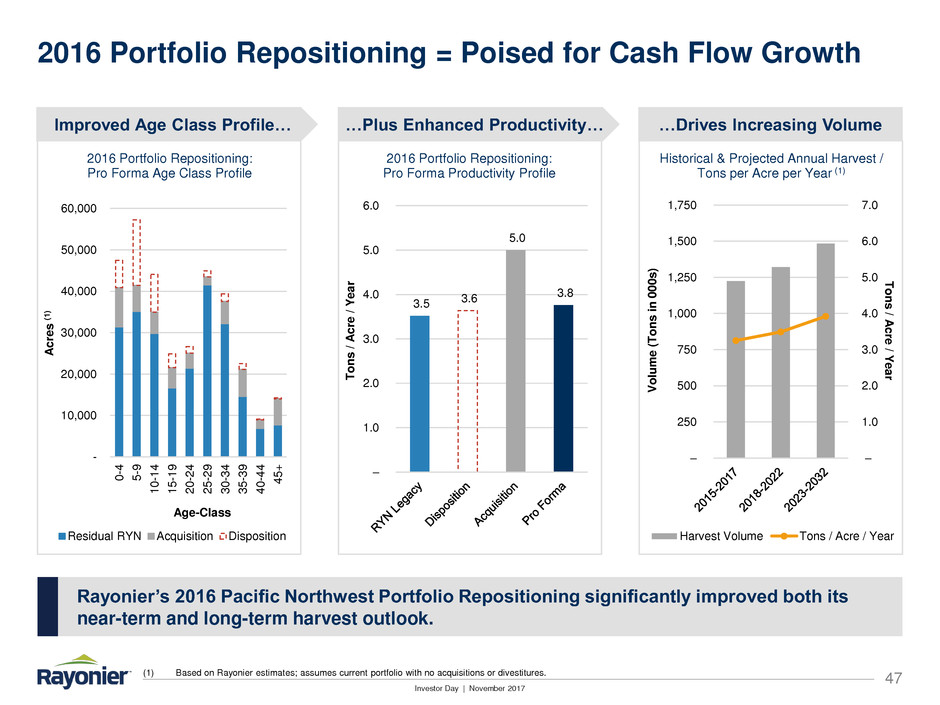
Investor Day | November 2017
2016 Portfolio Repositioning = Poised for Cash Flow Growth
47
Improved Age Class Profile…
Rayonier’s 2016 Pacific Northwest Portfolio Repositioning significantly improved both its
near-term and long-term harvest outlook.
(1) Based on Rayonier estimates; assumes current portfolio with no acquisitions or divestitures.
…Plus Enhanced Productivity… …Drives Increasing Volume
2016 Portfolio Repositioning:
Pro Forma Age Class Profile
2016 Portfolio Repositioning:
Pro Forma Productivity Profile
Historical & Projected Annual Harvest /
Tons per Acre per Year (1) -
10,000
20,000
30,000
40,000
50,000
60,000
0
-4
5
-9
1
0
-1
4
1
5
-1
9
2
0
-2
4
2
5
-2
9
3
0
-3
4
3
5
-3
9
4
0
-4
4
4
5
+
A
c
re
s
(
1
)
Age-Class
Residual RYN Acquisition Disposition
3.5 3.6
5.0
3.8
–
1.0
2.0
3.0
4.0
5.0
6.0
T
o
n
s
/
A
c
re
/
Y
e
a
r
–
1.0
2.0
3.0
4.0
5.0
6.0
7.0
–
250
500
750
1,000
1,250
1,500
1,750
T
o
n
s
/ A
c
re
/ Y
e
a
r
Volum
e
(Ton
s
in
0
0
0
s
)
Harvest Volume Tons / Acre / Year

Investor Day | November 2017
New Zealand Timber – Portfolio Overview
48
Highlights / Location
Source: NZ Ministry for Primary Industries, New Zealand Journal of Forestry.
(1) Site index reflects the average height of the dominant and codominant trees at a base age of 20 (New Zealand).
(2) Age class profile as of 12/31/16 per 2016 10-K.
* Non-GAAP measure (see Appendix for definitions and RYN reconciliations).
Strong Productivity Characteristics
Balanced Age Class Profile (Radiata) (2)
–
25
50
75
100
125
Radiata Pine
Regional Avg.
Industrially-Managed
Radiata Average
Rayonier
Radiata Average
Sit
e I
nd
ex
in
Fe
et
▪ Acreage: 429,000 acres
▪ Sustainable Yield: 2.3 million tons
▪ Planted / Plantable: 69%
▪ Average Site Index: 94 feet at age 20(1)
▪ 2016 EBITDA*: $58 million
▪ YTD Q3 2017 EBITDA*: $86 million
▪ Forest Stewardship Council Certification
(1
)
–
10
20
30
40
50
60
0-4 5-9 10-14 15-19 20-24 25+ Other
Species
Ac
re
s i
n
00
0s
Age Class in Years

Investor Day | November 2017
Diversified Mix of Domestic & Export Markets
49
Volume by Market Destination (FY 2016)
Over 60% of the New Zealand segment’s volume (including Trading volume) is sold into
export markets, with China being the largest source of demand.
RMF Domestic
37%
RMF Export
30%
Trading Export
33%
China
56%Korea
21%
India
17%
Other
6%

Investor Day | November 2017
Inventory Levels Drive Near-Term Price Fluctuations
50
Inventory-to-Demand Ratio vs. Export Log Price
Export supply / demand is generally considered in balance when the ratio of port inventory to average
monthly demand is between 1.3 and 2.0 times. Inventory typically spikes around the Chinese New Year.
Source: Rayonier estimates.
$-
$20
$40
$60
$80
$100
$120
$140
$160
$180
-
0.5
1.0
1.5
2.0
2.5
3.0
3.5
4.0
4.5
J FMAMJ J ASONDJ FMAMJ J ASONDJ FMAMJ J ASOND J FMAMJ J ASOND J FMAMJ J ASONDJ FMAMJ J ASOND J FMAMJ J ASO
2011 2012 2013 2014 2015 2016 2017
Chin
a CFR U
S$/ m
3JAS
Inv
en
tor
y -
to-
De
ma
nd
Rat
io
(3-
mo
nth
A
vg
. De
ma
nd
)
Supply demand range considered in balance
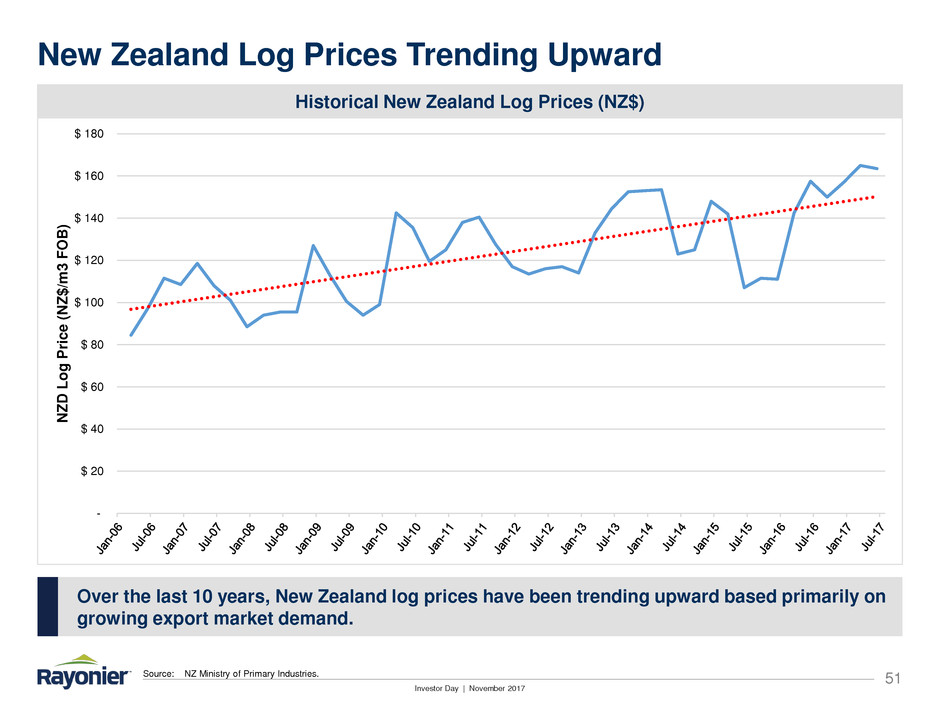
Investor Day | November 2017
New Zealand Log Prices Trending Upward
51
Historical New Zealand Log Prices (NZ$)
Over the last 10 years, New Zealand log prices have been trending upward based primarily on
growing export market demand.
Source: NZ Ministry of Primary Industries.
-
$ 20
$ 40
$ 60
$ 80
$ 100
$ 120
$ 140
$ 160
$ 180
NZ
D
Log
Pr
ice
(NZ$/
m3
FO
B)
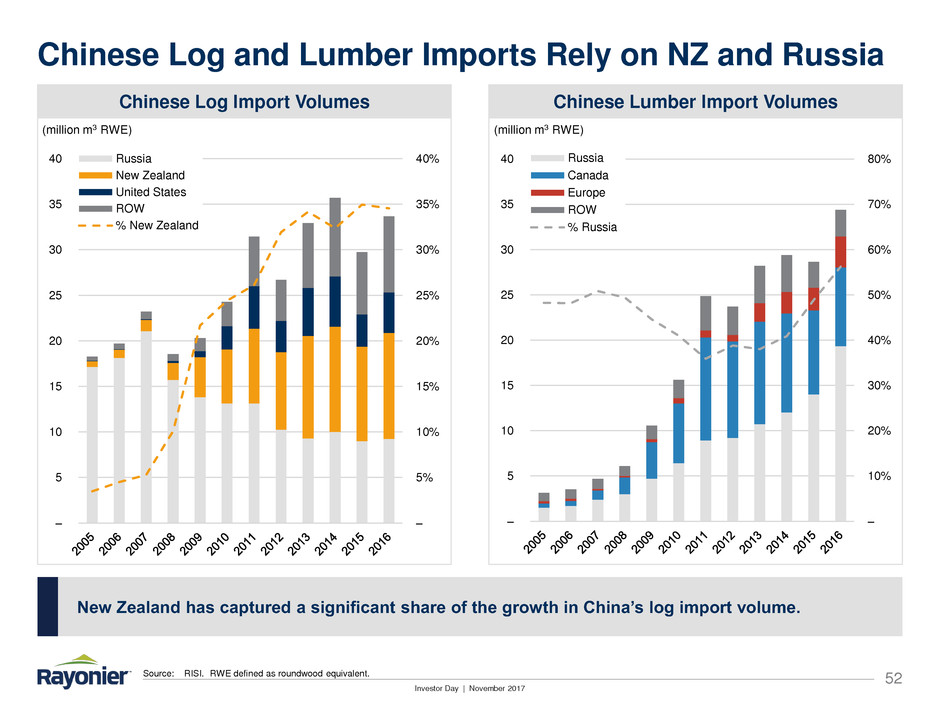
Investor Day | November 2017
Chinese Log and Lumber Imports Rely on NZ and Russia
52
Chinese Log Import Volumes
New Zealand has captured a significant share of the growth in China’s log import volume.
Source: RISI. RWE defined as roundwood equivalent.
Chinese Lumber Import Volumes
(million m3 RWE) (million m3 RWE)
–
10%
20%
30%
40%
50%
60%
70%
80%
–
5
10
15
20
25
30
35
40 Russia
Canada
Europe
ROW
% Russia
–
5%
10%
15%
20%
25%
30%
35%
40%
–
5
10
15
20
25
30
35
40 Russia
New Zealand
United States
ROW
% New Zealand
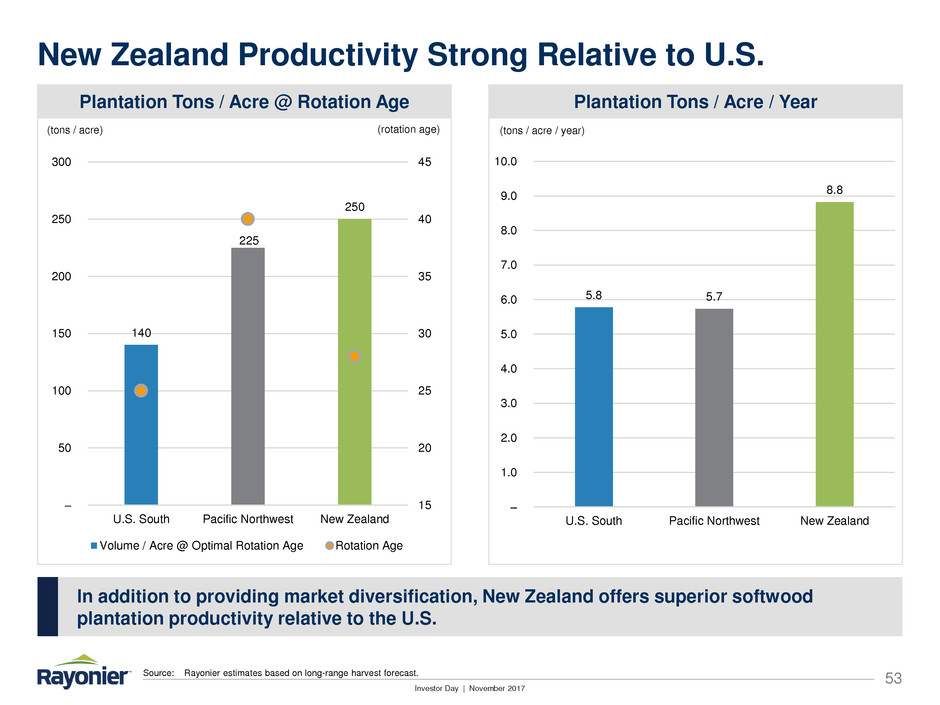
Investor Day | November 2017
53
Plantation Tons / Acre @ Rotation Age Plantation Tons / Acre / Year
Source: Rayonier estimates based on long-range harvest forecast.
In addition to providing market diversification, New Zealand offers superior softwood
plantation productivity relative to the U.S.
New Zealand Productivity Strong Relative to U.S.
(tons / acre) (rotation age) (tons / acre / year)
140
225
250
15
20
25
30
35
40
45
–
50
100
150
200
250
300
U.S. South Pacific Northwest New Zealand
Volume / Acre @ Optimal Rotation Age Rotation Age
5.8 5.7
8.8
–
1.0
2.0
3.0
4.0
5.0
6.0
7.0
8.0
9.0
10.0
U.S. S uth Pacific Northwest New Zealand

Investor Day | November 2017
Real Estate / HBU Strategy
54
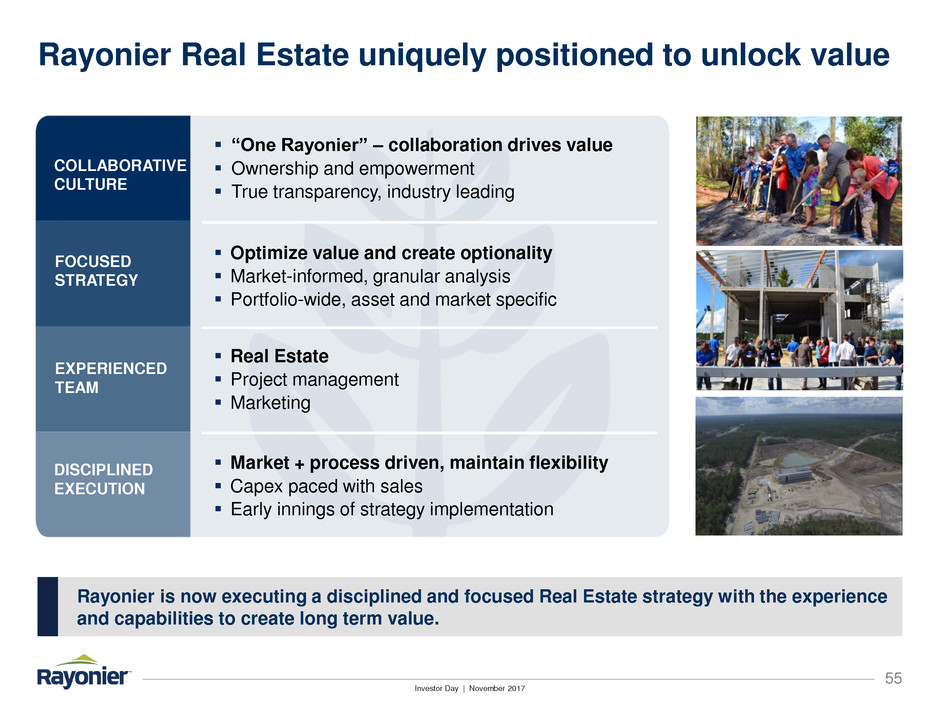
Investor Day | November 2017
Rayonier is now executing a disciplined and focused Real Estate strategy with the experience
and capabilities to create long term value.
Rayonier Real Estate uniquely positioned to unlock value
55
COLLABORATIVE
CULTURE
FOCUSED
STRATEGY
EXPERIENCED
TEAM
DISCIPLINED
EXECUTION
“One Rayonier” – collaboration drives value
Ownership and empowerment
True transparency, industry leading
Optimize value and create optionality
Market-informed, granular analysis
Portfolio-wide, asset and market specific
Real Estate
Project management
Marketing
Market + process driven, maintain flexibility
Capex paced with sales
Early innings of strategy implementation

Investor Day | November 2017
Maximize and grow annual gross margin/ac
Build diverse portfolio of cash flows
Develop new business growth
Real Estate strategy: optimize value & create optionality
Timberlands Real Estate
Sale of properties with
development rights
Invest in securing
development rights
Build a pipeline of
entitled properties in
higher potential
markets
HBU premium + ROI
Grow in
select markets
Sale of rural
properties
Stable and recurring
source of cash flows
Build a pipeline of
enhanced rural
properties in higher
potential markets
HBU premium + ROI
Grow moderately
Strategic sales of
timberland
Opportunistic-only for
capital allocation
Upgrade portfolio
Excluded from Adj.
EBITDA and pro-
forma financials
Timberland value
Opportunistic
Land
Resources
Sale of non-strategic and
timberland assets
Timberland: capture a
financial premium
Non-Strategic:
monetize and
repurpose “dead-
capital”
Timberland premium
Reduce reliance
Non-Strategic /
Timberlands
Rural Places +
Properties
Unimproved
Development
Sale of developed
land parcels
Invest in infrastructure
and amenities
Enhance value and
create optionality of
adjacent RYN
properties
HBU premium + ROI
+ optionality
Grow in
very select markets
Improved
Development
Large
Dispositions
Sale of
access to use
properties /
extract
resources
Annual
gross
margin
per acre
Grow
moderately
56

Investor Day | November 2017
Making progress and just getting started: price growth
2011 – 2014 Price per Acre
Rayonier has realized stronger pricing on real estate than its timber REIT peers. Excluding
Large Dispositions, Rayonier’s real estate sales are heavily focused on HBU properties.
Note: Price per acre based on weighted average sales price over the periods shown.
(1) Acres sold and price per acre for NS / Timberlands only, excludes large dispositions.
2015 – Q3 2017 Price per Acre
($ per acre) ($ per acre)
(1)
(1)
+24%
+85%
57
Average Price: $2,160/ac Average Price: $2,749/ac
+27%
+27%

Investor Day | November 2017
I-95 Coastal Corridor: active portfolio management
BRYAN COUNTY – US 17
RICHMOND HILL 1
KILKENNY
RICHMOND HILL 2
EAST NASSAU NORTHERN
WEST NASSAU 3
ST MARYS BLUFF’S
ST MARYS / EXIT 1 GA
EAST NASSAU REMAINDER
EAST NASSAU SOUTHERN
WEST NASSAU 1
WEST NASSAU 2
DEEP CREEK
SOUTH ST. JOHNS
WITWORTH
I-95 / US1 INTERCHANGE
PEDRO MENENDEZ
PELLICER CREEK
NEOGA LAKES
BELFAST COMMERCE PARK
RICHMOND HILL 3
CRANDALL
CHESTER RD.
EAST NASSAU DSAP
NORTH ST. JOHNS
BELFAST Commerce Park
BELFAST Mixed Use
EAST NASSAU Residential / Hospitality
CHESTER RD.
WILDLIGHT
NORTH ST. JOHNS
58
Active projects (Improved)
Other Rayonier properties
Rayonier planning areas
Active projects (Unimproved)
Under evaluation
Optimize timberland value
as of 10/31/2017
CRAWFORD DIAMOND
Recent transactions
• Wildlight 1.5 ac | $318,100/ac
• North St. Johns 215 ac | $27,100/ac
• Richmond Hill 1 8.8 ac | $91,400/ac
• Crawford Diamond 1,311 ac | $10,000/ac
• Deep Creek 1,994 ac | $3,200/ac

Investor Day | November 2017
261 net-acre master planned community north of
Jacksonville, Florida
Well positioned in a growing sub-market
Initial infrastructure nearing completion
Rayonier owns ~25,000 acres in a 5-mile radius
Land use entitlements in place to support future
growth
Catalytic projects complete or underway
Overview of Wildlight Community Development
59
Our strategy is to target Northeast Florida market demand and catalyze value across our
significant land holdings over time.
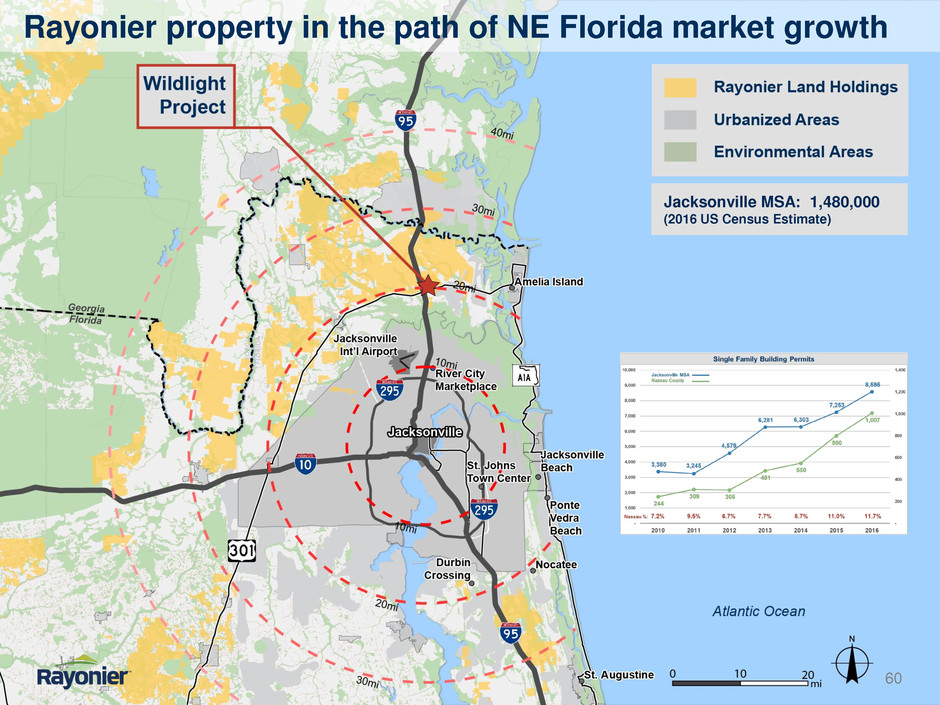
Investor Day | November 2017
Jacksonville MSA: 1,480,000
(2016 US Census Estimate)
60
Rayonier property in the path of NE Florida market growth

Investor Day | November 2017
Wildlight progress
Wildlight Elementary School
Rayonier office building
Significant infrastructure
First commercial sale
Announced two homebuilders
First residential sale
Strategic Alliance with the University of Florida to
construct health facilities
Stewardship District legislative approval
AT&T to provide gigabit speed network
Prospect pipeline building
Past 12 Months
The Wildlight project is well positioned as we head into 2018.
New elementary school
Village Center underway
Model home under construction
61

Investor Day | November 2017
Significant catalytic projects now complete or underway
New elementary school New Rayonier HQ building
Highway improvements underway Future UF Health facility
62
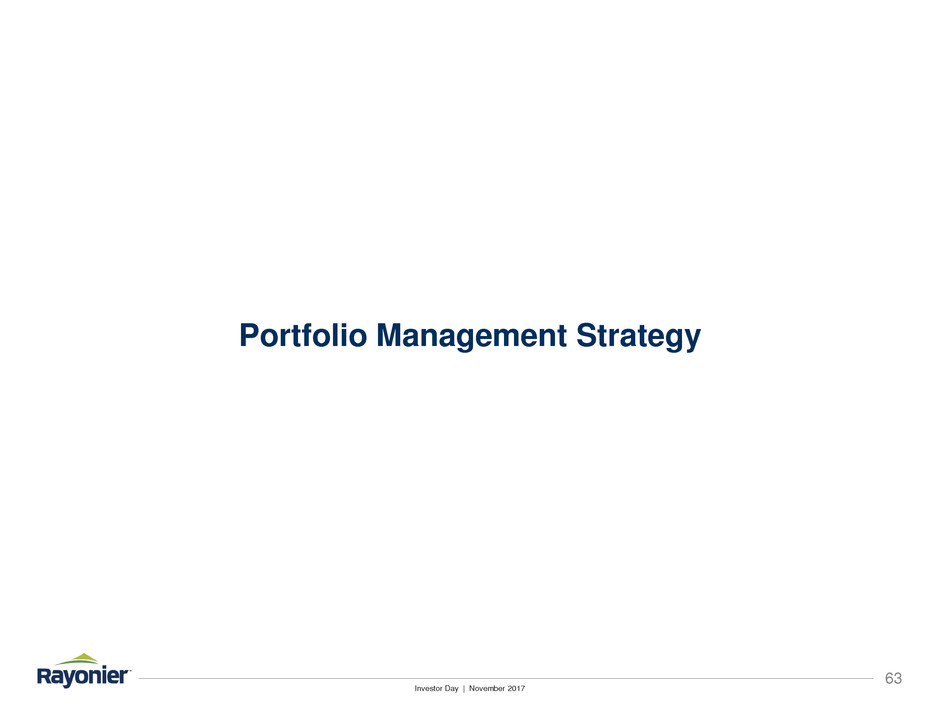
Investor Day | November 2017
Portfolio Management Strategy
63

Investor Day | November 2017
Creating Value Through Active Portfolio Management
64
Never satisfied with portfolio and processes – constantly monitoring, adapting and improving
to create long-term value.
OPPORTUNITY
Leverage Expertise
Focus on Right
Opportunities
Be Nimble Be Disciplined
Team of experts
able to evaluate
complex deals
Assumptions
come from people
closest to asset
Collaborative
decision process
where each
acquisition /
disposition is
debated
Pursue bolt-on
and large strategic
acquisitions
Use staged gating
process to
efficiently evaluate
acquisitions
Assess risk /
reward on a case-
by-case basis
Softwood regions
with tensioned
wood baskets
Only enter new
markets when
sufficient scale is
possible
Leverage NAV
analysis to
understand
portfolio at
granular level
Don’t pay for
synergies
Consider
alternative uses of
capital when
determining value
Sell when others
are willing to pay
more than intrinsic
value
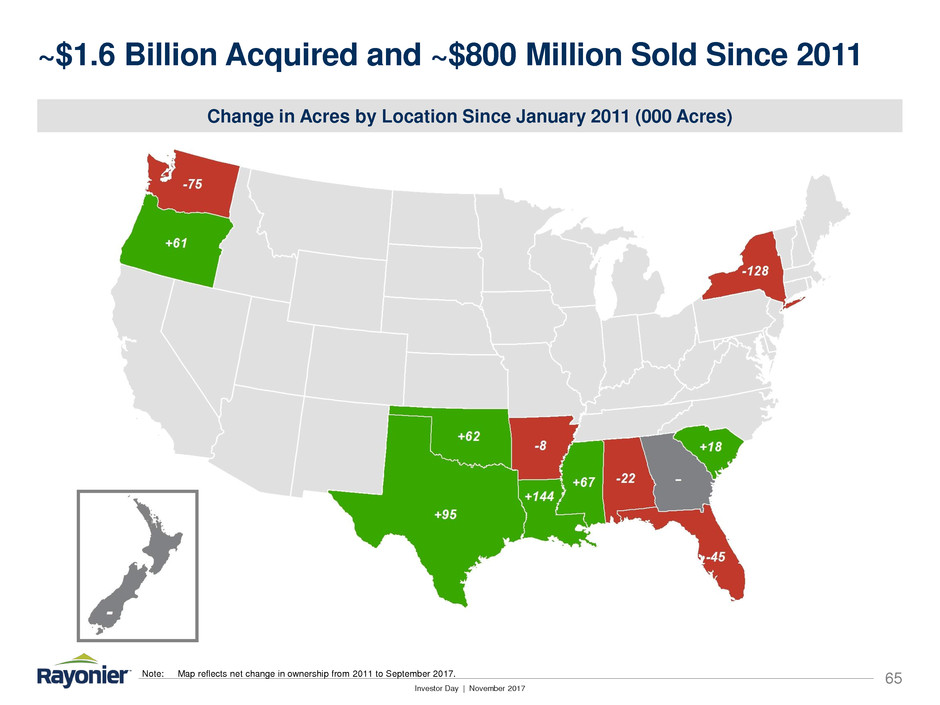
Investor Day | November 2017
~$1.6 Billion Acquired and ~$800 Million Sold Since 2011
65Note: Map reflects net change in ownership from 2011 to September 2017.
-128
Change in Acres by Location Since January 2011 (000 Acres)
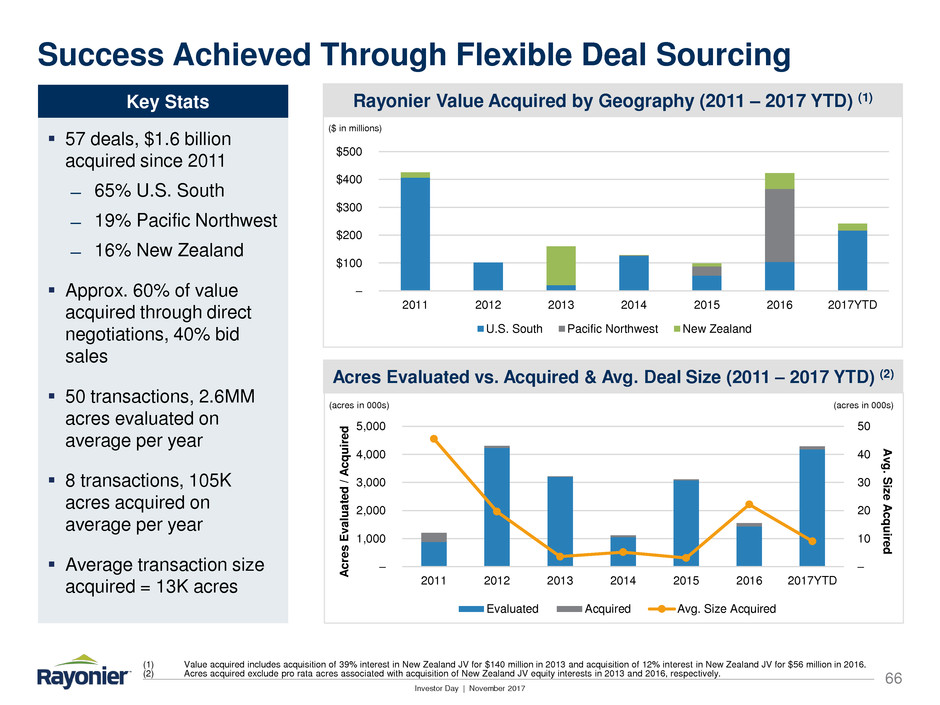
Investor Day | November 2017
Success Achieved Through Flexible Deal Sourcing
66
Rayonier Value Acquired by Geography (2011 – 2017 YTD) (1)
(1) Value acquired includes acquisition of 39% interest in New Zealand JV for $140 million in 2013 and acquisition of 12% interest in New Zealand JV for $56 million in 2016.
(2) Acres acquired exclude pro rata acres associated with acquisition of New Zealand JV equity interests in 2013 and 2016, respectively.
Acres Evaluated vs. Acquired & Avg. Deal Size (2011 – 2017 YTD) (2)
Key Stats
57 deals, $1.6 billion
acquired since 2011
̶ 65% U.S. South
̶ 19% Pacific Northwest
̶ 16% New Zealand
Approx. 60% of value
acquired through direct
negotiations, 40% bid
sales
50 transactions, 2.6MM
acres evaluated on
average per year
8 transactions, 105K
acres acquired on
average per year
Average transaction size
acquired = 13K acres
($ in millions)
(acres in 000s) (acres in 000s)
–
$100
$200
$300
$400
$500
2011 2012 2013 2014 2015 2016 2017YTD
U.S. South Pacific Northwest New Zealand
–
10
20
30
40
50
–
1,000
2,000
3,000
4,000
5,000
2011 2012 2013 2014 2015 2016 2017YTD
Evaluated Acquired Avg. Size Acquired
Ac
res
Ev
alu
ate
d /
Ac
quir
ed Avg. Size Acquired
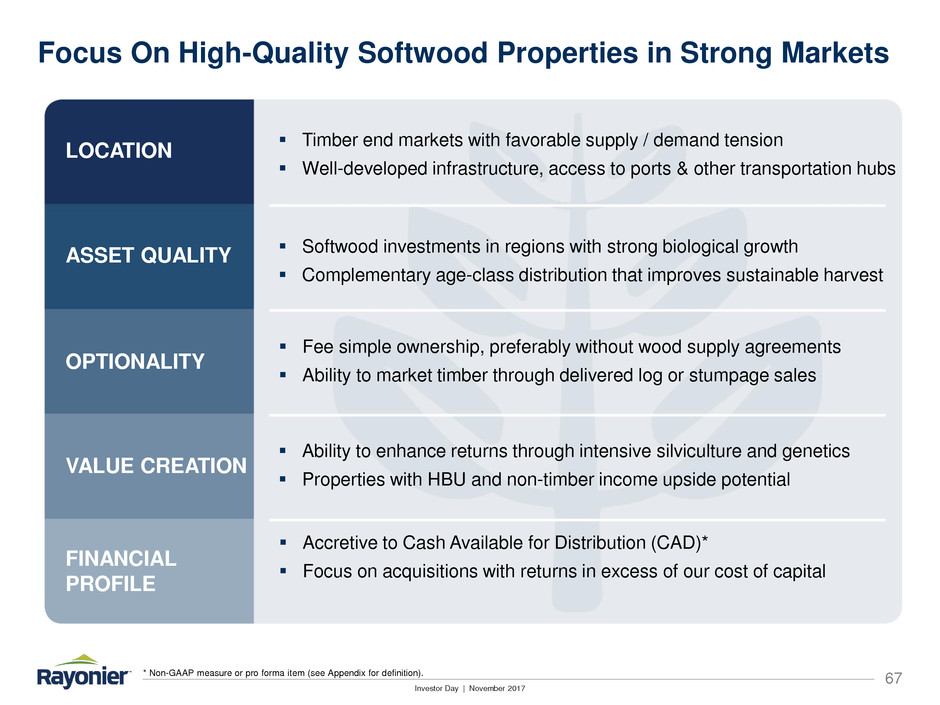
Investor Day | November 2017
67
Focus On High-Quality Softwood Properties in Strong Markets
LOCATION
ASSET QUALITY
OPTIONALITY
VALUE CREATION
FINANCIAL
PROFILE
Timber end markets with favorable supply / demand tension
Well-developed infrastructure, access to ports & other transportation hubs
Ability to enhance returns through intensive silviculture and genetics
Properties with HBU and non-timber income upside potential
Accretive to Cash Available for Distribution (CAD)*
Focus on acquisitions with returns in excess of our cost of capital
Fee simple ownership, preferably without wood supply agreements
Ability to market timber through delivered log or stumpage sales
Softwood investments in regions with strong biological growth
Complementary age-class distribution that improves sustainable harvest
* Non-GAAP measure or pro forma item (see Appendix for definition).
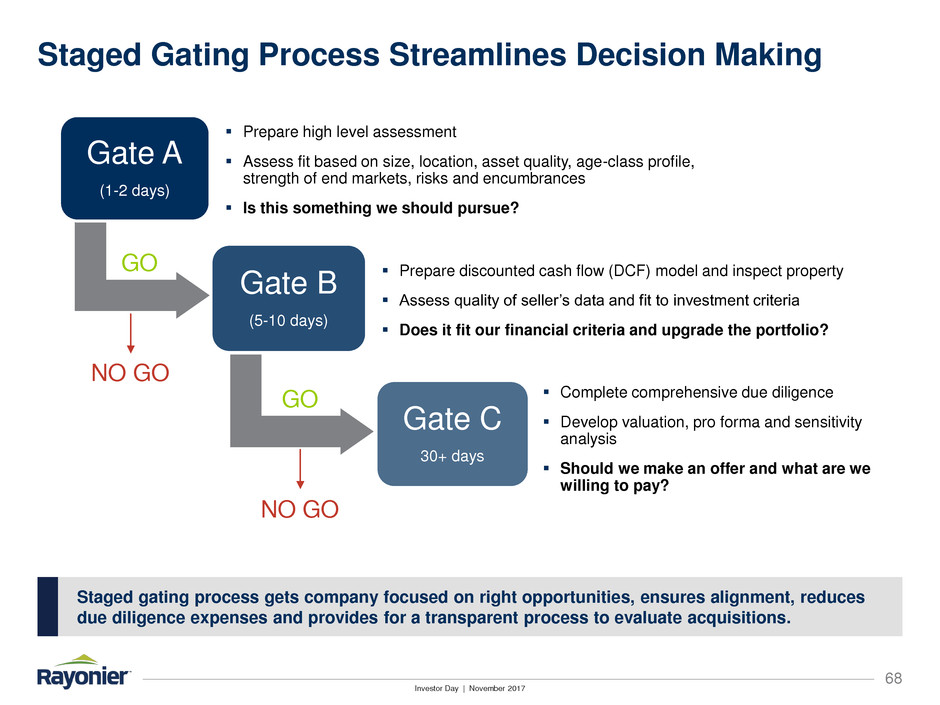
Investor Day | November 2017
Staged Gating Process Streamlines Decision Making
68
Staged gating process gets company focused on right opportunities, ensures alignment, reduces
due diligence expenses and provides for a transparent process to evaluate acquisitions.
Gate A
(1-2 days)
Gate B
(5-10 days)
Gate C
30+ days
Prepare discounted cash flow (DCF) model and inspect property
Assess quality of seller’s data and fit to investment criteria
Does it fit our financial criteria and upgrade the portfolio?
Complete comprehensive due diligence
Develop valuation, pro forma and sensitivity
analysis
Should we make an offer and what are we
willing to pay?
Prepare high level assessment
Assess fit based on size, location, asset quality, age-class profile,
strength of end markets, risks and encumbrances
Is this something we should pursue?
GO
NO GO
GO
NO GO

Investor Day | November 2017
Portfolio Management Valuation Framework
69
Rayonier employs a rigorous, multi-faceted valuation analysis in arriving at its bid / ask
values for timberland acquisitions / dispositions.
Cost Approach:
Quickest valuation methodology
Current market prices used to
value merchantable timber
Land Expectation Value (LEV)
used to value land and pre-
merchantable timber
Comparable Sales:
Backward looking, but good to
bracket value
Helpful to identify arbitrage
opportunities
DCF Analysis:
Underwriting assumptions
developed by subject matter
experts
Discount rate varies by property
and geography
Sensitivity analysis used to refine
assumptions, quantify risks
Used to develop initial valuation Used to develop final valuation
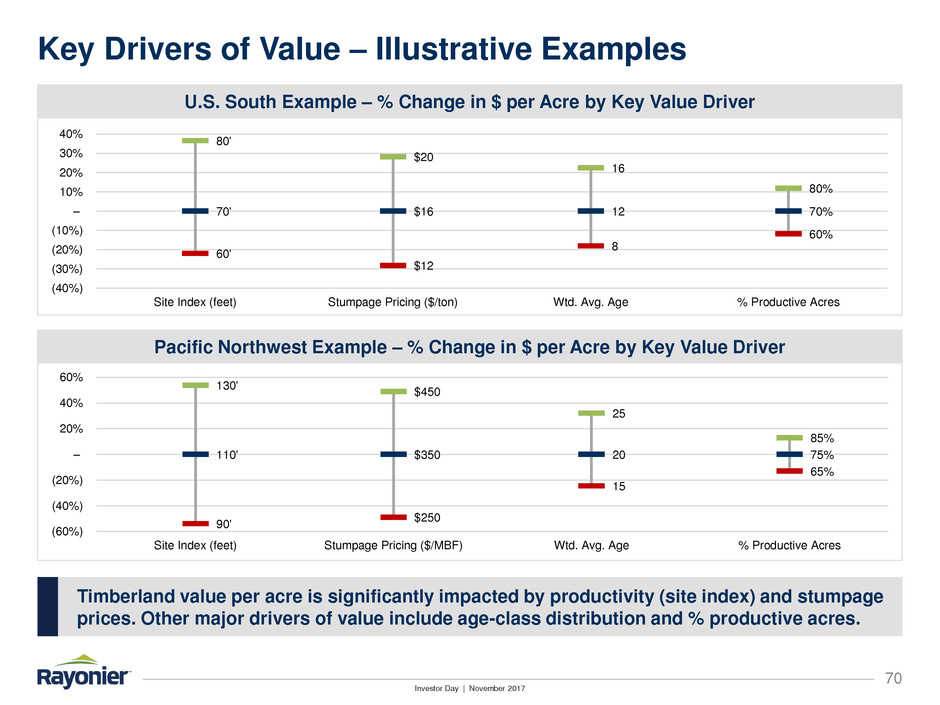
Investor Day | November 2017
Key Drivers of Value – Illustrative Examples
70
U.S. South Example – % Change in $ per Acre by Key Value Driver
Timberland value per acre is significantly impacted by productivity (site index) and stumpage
prices. Other major drivers of value include age-class distribution and % productive acres.
Pacific Northwest Example – % Change in $ per Acre by Key Value Driver
65%
75%
85%
90'
110'
130'
$250
$350
$450
15
20
25
(60%)
(40%)
(20%)
20%
40%
60%
Site Index (feet) Stumpage Pricing ($/MBF) Wtd. Avg. Age % Productive Acres
60%
70%
80%
60'
70'
80'
12
$16
$20
8
12
16
(40%)
(30%)
(20%)
(10%)
10%
20%
30%
40%
Site Index (feet) Stumpage Pricing ($/ton) Wtd. Avg. Age % Productive Acres

Investor Day | November 2017
Disciplined Acquisition Process = Improved Portfolio
71
Harvest Rate – Tons per Acre per Year (2)
Rayonier seeks to acquire properties that improve quality of portfolio and produce strong
recurring cash flow from sustainable harvest.
Productivity – Site Index (1)
Commercial Forest Area – % Productive (3)Weighted Average Plantation Age
Note: Comparison charts reflect data for U.S. legacy per 2014 10-K and acquisitions from 2014 to September 30, 2017.
(1) Site index base age = 25 years for U.S. South and 50 years for Pacific Northwest.
(2) Harvest rate for RYN Legacy assumes sustainable yield of 5.4 to 5.7 million tons for Southern Timber and 1.3 million tons for Pacific Northwest Timber (per 2014 10-K). Harvest rate for acquisitions based on
projected 10-year harvest.
(3) Includes land classified as natural plantable for Southern Timber segment.
75
122
70
110
50
70
90
110
130
150
U.S. South Pacific Northwest
Acquisitions Legacy
5.0 5.1
2.9
3.5
1.0
2.0
3.0
4.0
5.0
6.0
U.S. South Pacific Northwest
Acquisitions Legacy
72%
85%
68%
77%
50%
60%
70%
80%
90%
100%
U.S. South Pacific Northwest
Acquisitions Legacy
15
22
12
19
5
10
15
20
25
U.S. South Pacific Northwest
Acquisitions Legacy
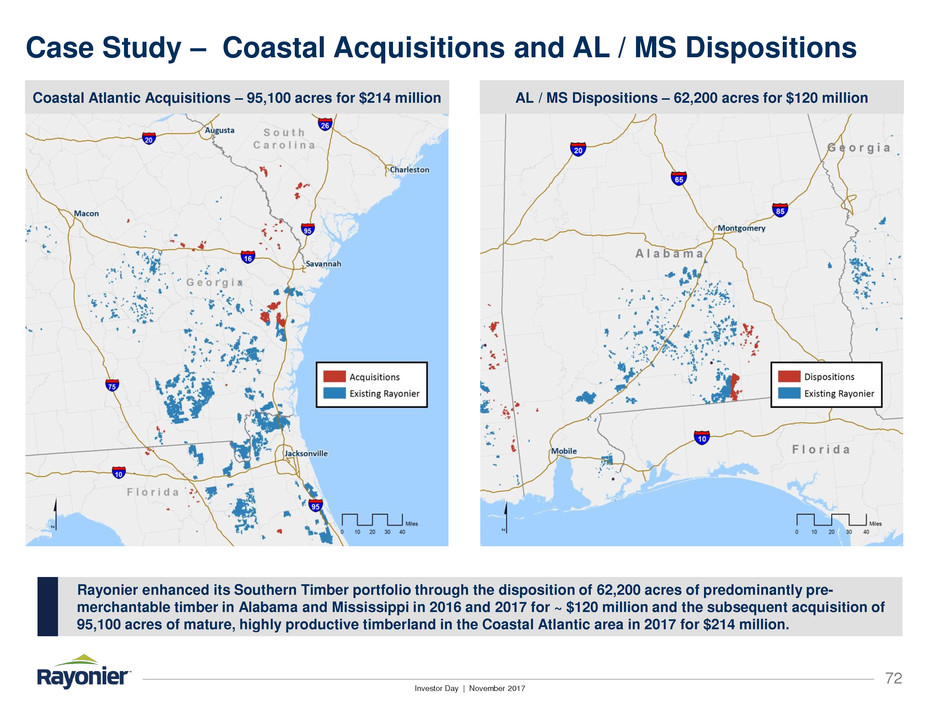
Investor Day | November 2017
Case Study – Coastal Acquisitions and AL / MS Dispositions
72
Rayonier enhanced its Southern Timber portfolio through the disposition of 62,200 acres of predominantly pre-
merchantable timber in Alabama and Mississippi in 2016 and 2017 for ~ $120 million and the subsequent acquisition of
95,100 acres of mature, highly productive timberland in the Coastal Atlantic area in 2017 for $214 million.
Coastal Atlantic Acquisitions – 95,100 acres for $214 million AL / MS Dispositions – 62,200 acres for $120 million

Investor Day | November 2017
–
$5
$10
$15
$20
$25
FL
-1
G
A-
2
S
C
-2
N
C
-2
FL
-2
LA-
1
V
A
-2
V
A
-1
LA-
2
AL-
2
TX-
1
S
C
-1
G
A-
1
TX-
2
M
S
-2
A
L-
1
A
R
-1
N
C
-1
A
R
-2
M
S
-1
TN-
1
TN-
2
Acquisition Markets
Disposition Markets
Average
Acquisitions Located in Strongest U.S. South Markets
73
The Acquisitions are located in the top three U.S. South timber markets, ranked by Timber
Mart-South average composite stumpage price by region.
Source: TimberMart-South.
(1) Composite pricing assumes mix of 50% pulpwood, 30% chip-n-saw and 20% sawtimber.
TMS 2016 Composite Price Quartile Rankings
Timber consumption vs. inventory growth remains much more tensioned in Coastal Atlantic markets as
compared to other U.S. South timber investment regions
The 2017 Coastal Atlantic Acquisitions are located in the top 3 markets, while the Dispositions are located in
markets ranked in the second and third quartiles(1)
TMS 2016 Composite Price by Region
Top 3
Markets
Acquisitions
Dispositions

Investor Day | November 2017
Transactions Improve Age-Class Distribution and Rate of Harvest
74
% of Plantation Acres by Age-Class (1)
Capital from the Dispositions was used to partially fund the Coastal Atlantic Acquisitions,
which have a more mature age-class distribution and higher rate of harvest.
(1) Legacy data from 2015 Form 10-K. Harvest rate based on Company estimate of sustainable yield for Dispositions / Acquisitions and 2015 Form 10-K estimate of 5.5 to
5.8 million tons for Legacy Southern Timber segment.
% Change by Age-Class (Acquisition – Disposition)
Harvest Rate (tons / acre / year)Merchantable Timber Stocking (tons / gross acre)
3.0
4.3
4.7
–
1.0
2.0
3.0
4.0
5.0
Legacy Dispositions Acquisitions
–
5%
10%
15%
20%
25%
30%
35%
40%
0-4 5-9 10-14 15-19 20-24 25-29 30+
Legacy Dispositions Acquisitions (30%)
(25%)
(20%)
(15%)
(10%)
(5%)
–
5%
10%
15%
0-4 5-9 10-14 15-19 20-24 25-29 30+
35
29
45
–
10
20
30
40
50
Legacy Dispositions Acqu sitions

Investor Day | November 2017
Appendix
75

Investor Day | November 2017
Biographies
76
David L. Nunes | President and CEO Service since: 2014
Mr. Nunes has more than three decades of forest products industry experience. He has served in key
leadership positions at several timber and real estate companies, including CEO and president, and has
substantial background in the areas of timberland management and investments, marketing, strategic
planning, mergers and acquisitions and capital planning.
Douglas M. Long | SVP, U.S. Operations Service since: 1995
Mr. Long joined Rayonier in 1995 as a GIS Forestry Analyst, and has held multiple positions of increasing
responsibility within the forestry division. From 2003-2007, he was a Forest Services Manager and a
Regional Manager in Rayonier’s New Zealand operations. In 2007, he returned to the U.S., where he
served as Southwest Resource Unit Leader. In 2014, he was promoted to lead U.S. Forest Resources.
Christopher T. Corr | SVP, Real Estate and Public Affairs Service since: 2013
Mr. Corr joined Rayonier in 2013. Prior to joining, he served as Executive Vice President, Buildings and
Places for AECOM, a global provider of technical and management support services, including real estate
planning and development. Chris previously served as Executive Vice President and Chief Strategy Officer
of The St. Joe Company. He was also an executive at The Walt Disney Company.
Mark McHugh | SVP and CFO Service since: 2014
Mr. McHugh has 17 years of experience in finance and capital markets focusing on the timberland and
REIT sectors. Mark joined Rayonier from Raymond James, where he served as Managing Director in the
firm’s Real Estate Investment Banking group, responsible for the firm’s timberland and agriculture sector
coverage.
Rhett Rogers | VP, Portfolio Management Service since: 2001
Mr. Rogers joined Rayonier in 2001 as a District Technical Forester, and has held multiple positions of
increasing responsibility. From 2005-2007, he was a Timberland Acquisitions Supervisor in Hoquiam,
Washington. In 2007, he was promoted to Resource Unit Leader of Rayonier’s Coastal Resource Unit
based in Yulee, Florida and most recently served as Director, Land Asset Management since August 2014.
He was promoted to his current position in February 2017.
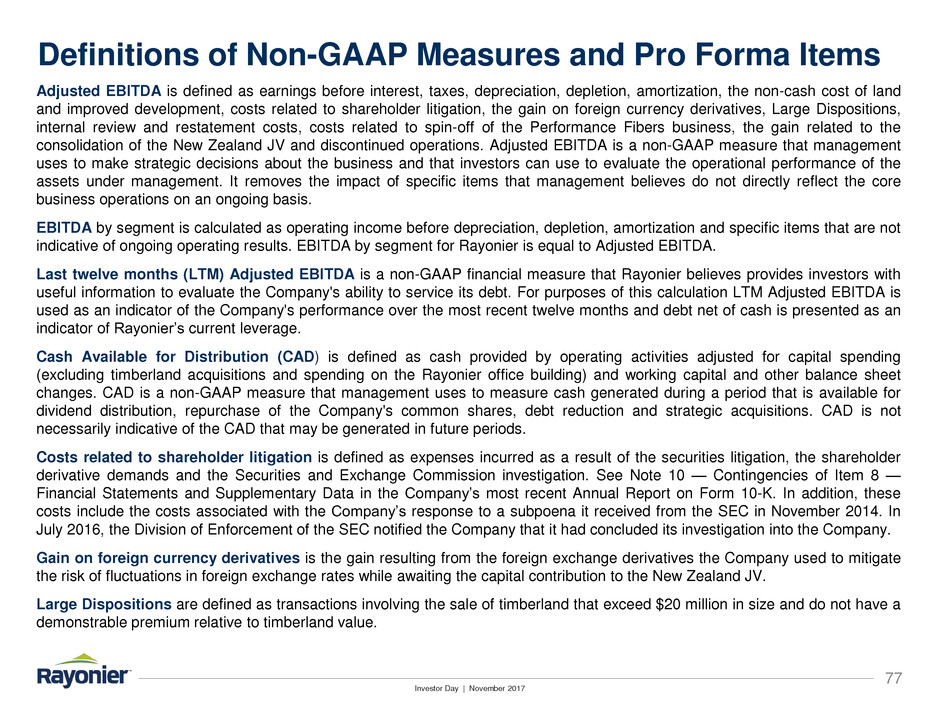
Investor Day | November 2017
Definitions of Non-GAAP Measures and Pro Forma Items
77
Adjusted EBITDA is defined as earnings before interest, taxes, depreciation, depletion, amortization, the non-cash cost of land
and improved development, costs related to shareholder litigation, the gain on foreign currency derivatives, Large Dispositions,
internal review and restatement costs, costs related to spin-off of the Performance Fibers business, the gain related to the
consolidation of the New Zealand JV and discontinued operations. Adjusted EBITDA is a non-GAAP measure that management
uses to make strategic decisions about the business and that investors can use to evaluate the operational performance of the
assets under management. It removes the impact of specific items that management believes do not directly reflect the core
business operations on an ongoing basis.
EBITDA by segment is calculated as operating income before depreciation, depletion, amortization and specific items that are not
indicative of ongoing operating results. EBITDA by segment for Rayonier is equal to Adjusted EBITDA.
Last twelve months (LTM) Adjusted EBITDA is a non-GAAP financial measure that Rayonier believes provides investors with
useful information to evaluate the Company's ability to service its debt. For purposes of this calculation LTM Adjusted EBITDA is
used as an indicator of the Company's performance over the most recent twelve months and debt net of cash is presented as an
indicator of Rayonier’s current leverage.
Cash Available for Distribution (CAD) is defined as cash provided by operating activities adjusted for capital spending
(excluding timberland acquisitions and spending on the Rayonier office building) and working capital and other balance sheet
changes. CAD is a non-GAAP measure that management uses to measure cash generated during a period that is available for
dividend distribution, repurchase of the Company's common shares, debt reduction and strategic acquisitions. CAD is not
necessarily indicative of the CAD that may be generated in future periods.
Costs related to shareholder litigation is defined as expenses incurred as a result of the securities litigation, the shareholder
derivative demands and the Securities and Exchange Commission investigation. See Note 10 — Contingencies of Item 8 —
Financial Statements and Supplementary Data in the Company’s most recent Annual Report on Form 10-K. In addition, these
costs include the costs associated with the Company’s response to a subpoena it received from the SEC in November 2014. In
July 2016, the Division of Enforcement of the SEC notified the Company that it had concluded its investigation into the Company.
Gain on foreign currency derivatives is the gain resulting from the foreign exchange derivatives the Company used to mitigate
the risk of fluctuations in foreign exchange rates while awaiting the capital contribution to the New Zealand JV.
Large Dispositions are defined as transactions involving the sale of timberland that exceed $20 million in size and do not have a
demonstrable premium relative to timberland value.
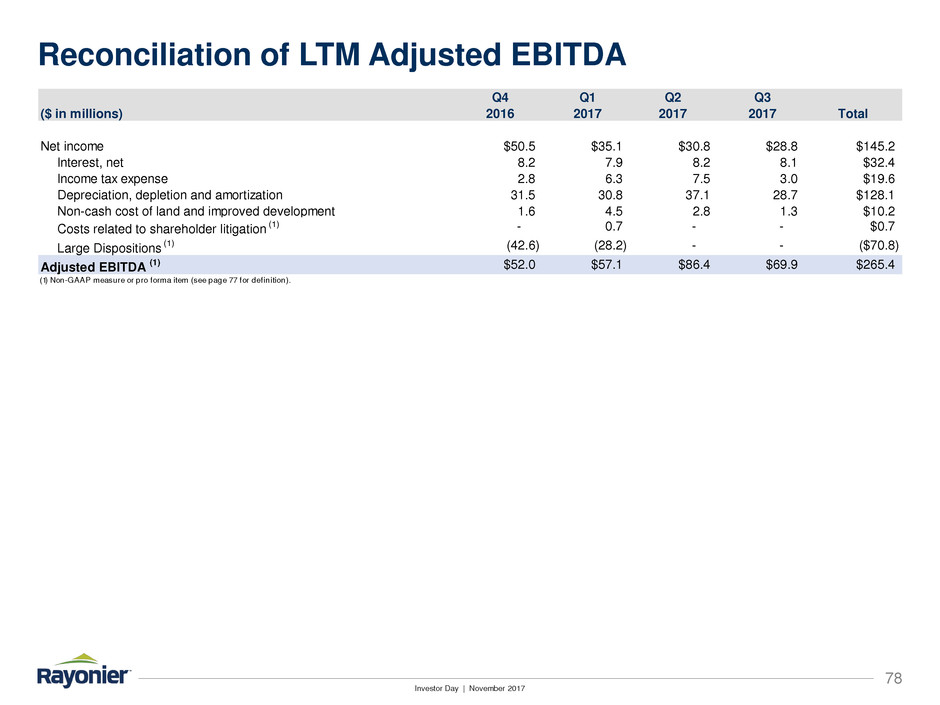
Investor Day | November 2017
Reconciliation of LTM Adjusted EBITDA
78
($ in millions)
Q4
2016
Q1
2017
Q2
2017
Q3
2017 Total
Net income $50.5 $35.1 $30.8 $28.8 $145.2
Interest, net 8.2 7.9 8.2 8.1 $32.4
Income tax expense 2.8 6.3 7.5 3.0 $19.6
Depreciation, depletion and amortization 31.5 30.8 37.1 28.7 $128.1
Non-cash cost of land and improved development 1.6 4.5 2.8 1.3 $10.2
Costs related to shareholder litigation
(1) - 0.7 - - $0.7
Large Dispositions
(1) (42.6) (28.2) - - ($70.8)
Adjusted EBITDA
(1) $52.0 $57.1 $86.4 $69.9 $265.4
(1) Non-GAAP measure or pro forma item (see page 77 for definition). x

Investor Day | November 2017
Reconciliation of Operating Income (Loss) to Adjusted
EBITDA by Segment
79
($ in millions)
Southern
Timber
Pacific
Northwest
Timber
New Zealand
Timber Real Estate Trading
Corporate
and Other Total
Q3 2017 LTM
Operating Income $43.2 ($4.4) $68.0 $106.6 $3.9 ($20.4) $196.9
Depreciation, depletion & amortization 49.7 34.0 35.6 8.2 - 0.6 128.1
Non-cash cost of land and real estate sold - - 0.1 10.1 - - 10.2
Non-operating income - - 0.3 - - - 0.3
Costs related to shareholder litigation
(1) - - - - - 0.7 0.7
Large Dispositions
(1) - - - (70.8) - - (70.8)
Adjusted EBITDA
(1) $92.9 $29.6 $104.0 $54.1 $3.9 ($19.1) $265.4
Q3 2017 YTD
Operating Income $35.0 ($1.3) $56.3 $57.3 $3.4 ($15.3) $135.4
Depreciation, depletion & amortization 37.1 23.8 29.3 5.9 - 0.5 96.6
Non-cash cost of land and real estate sold - - 0.1 8.5 - - 8.6
Non-operating income - - 0.3 - - - 0.3
Costs related to shareholder litigation
(1) - - - - - 0.7 0.7
Large Dispositions
(1) - - - (28.2) - - (28.2)
Adjusted EBITDA
(1) $72.1 $22.5 $86.0 $43.5 $3.4 ($14.1) $213.4
2016
Operating Income $43.1 ($4.0) $33.1 $202.4 $2.0 ($20.8) $255.8
Depreciation, depletion & amortization 49.8 25.2 23.4 16.3 - 0.4 115.1
Non-cash cost of land and real estate sold - - 1.8 9.9 - - 11.7
Costs related to shareholder litigation
(1) - - - - - 2.2 2.2
Gain on foreign currency derivatives
(1) - - - - - (1.2) (1.2)
Large Dispositions
(1) - - - (143.9) - - (143.9)
Adjusted EBITDA
(1) $92.9 $21.2 $58.3 $84.7 $2.0 ($19.4) $239.7
(1) Non-GAAP measure or pro forma item (see page 77 for definition).
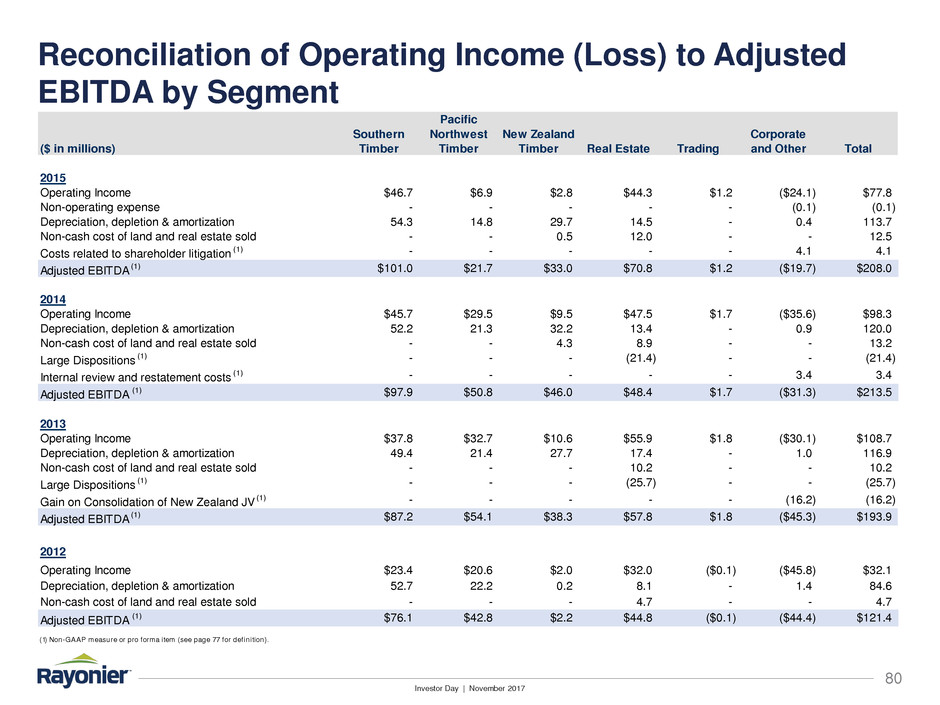
Investor Day | November 2017
Reconciliation of Operating Income (Loss) to Adjusted
EBITDA by Segment
80
($ in millions)
Southern
Timber
Pacific
Northwest
Timber
New Zealand
Timber Real Estate Trading
Corporate
and Other Total
2015
Operating Income $46.7 $6.9 $2.8 $44.3 $1.2 ($24.1) $77.8
Non-operating expense - - - - - (0.1) (0.1)
Depreciation, depletion & amortization 54.3 14.8 29.7 14.5 - 0.4 113.7
Non-cash cost of land and real estate sold - - 0.5 12.0 - - 12.5
Costs related to shareholder litigation
(1) - - - - - 4.1 4.1
Adjusted EBITDA
(1) $101.0 $21.7 $33.0 $70.8 $1.2 ($19.7) $208.0
2014
Operating Income $45.7 $29.5 $9.5 $47.5 $1.7 ($35.6) $98.3
Depreciation, depletion & amortization 52.2 21.3 32.2 13.4 - 0.9 120.0
Non-cash cost of land and real estate sold - - 4.3 8.9 - - 13.2
Large Dispositions
(1) - - - (21.4) - - (21.4)
Internal review and restatement costs
(1) - - - - - 3.4 3.4
Adjusted EBITDA
(1) $97.9 $50.8 $46.0 $48.4 $1.7 ($31.3) $213.5
2013
Operating Income $37.8 $32.7 $10.6 $55.9 $1.8 ($30.1) $108.7
Depreciation, depletion & amortization 49.4 21.4 27.7 17.4 - 1.0 116.9
Non-cash cost of land and real estate sold - - - 10.2 - - 10.2
Large Dispositions
(1) - - - (25.7) - - (25.7)
Gain on Consolidation of New Zealand JV
(1) - - - - - (16.2) (16.2)
Adjusted EBITDA
(1) $87.2 $54.1 $38.3 $57.8 $1.8 ($45.3) $193.9
2012
Operating Income $23.4 $20.6 $2.0 $32.0 ($0.1) ($45.8) $32.1
Depreciation, depletion & amortization 52.7 22.2 0.2 8.1 - 1.4 84.6
Non-cash cost of land and real estate sold - - - 4.7 - - 4.7
Adjusted EBITDA
(1) $76.1 $42.8 $2.2 $44.8 ($0.1) ($44.4) $121.4
(1) Non-GAAP measure or pro forma item (see page 77 for definition). x
Serious News for Serious Traders! Try StreetInsider.com Premium Free!
You May Also Be Interested In
- Valstybės investicinis kapitalas UAB audited Annual information for the year 2023
- Guanajuato Silver Announces Brokered LIFE Offering of Units
- World Intellectual Property Day: OPPO Maintains Top 10 Global IP Ranking for Fifth Consecutive Year
Create E-mail Alert Related Categories
SEC FilingsSign up for StreetInsider Free!
Receive full access to all new and archived articles, unlimited portfolio tracking, e-mail alerts, custom newswires and RSS feeds - and more!



 Tweet
Tweet Share
Share